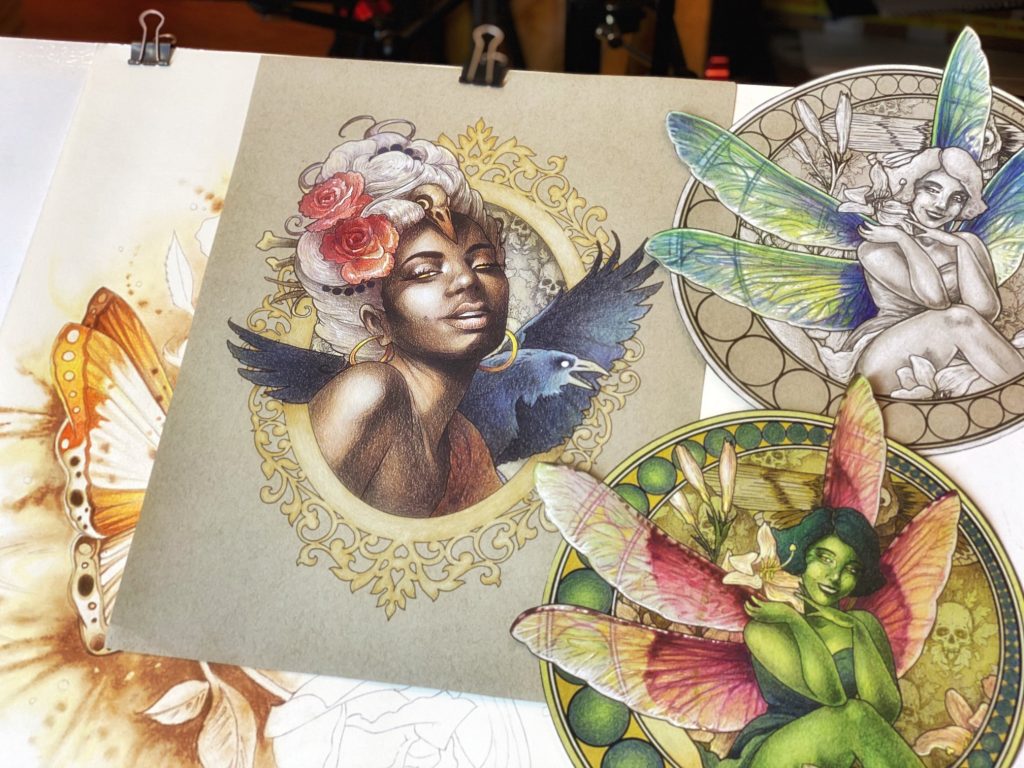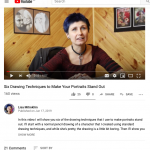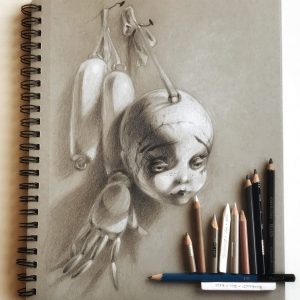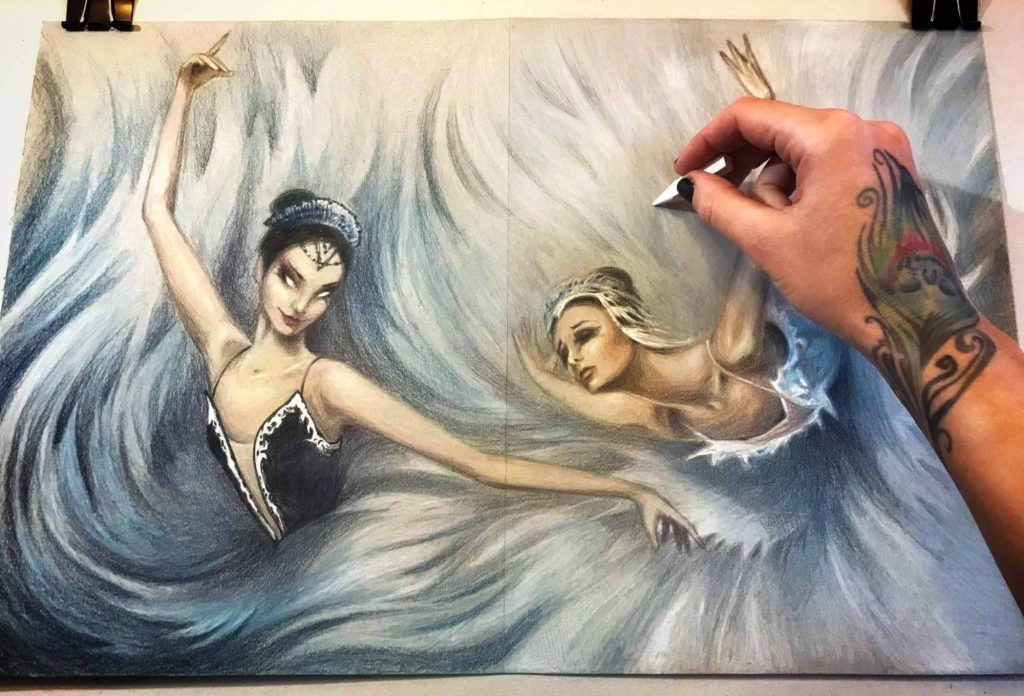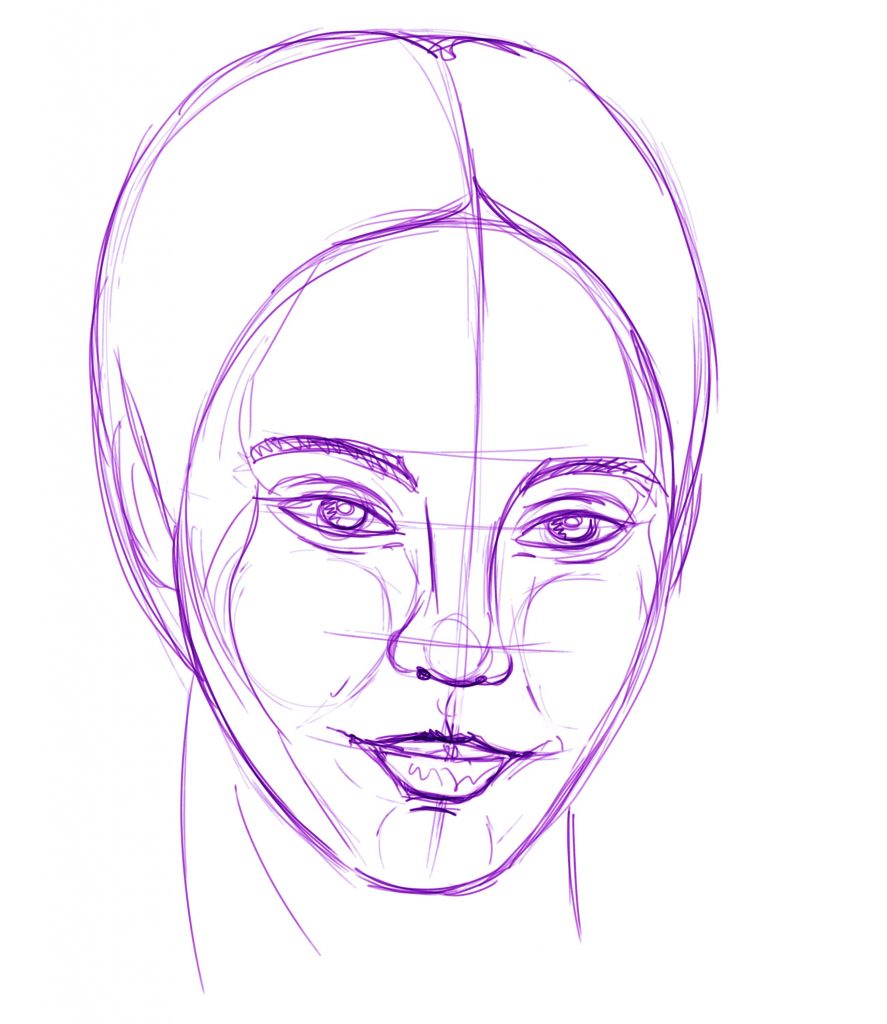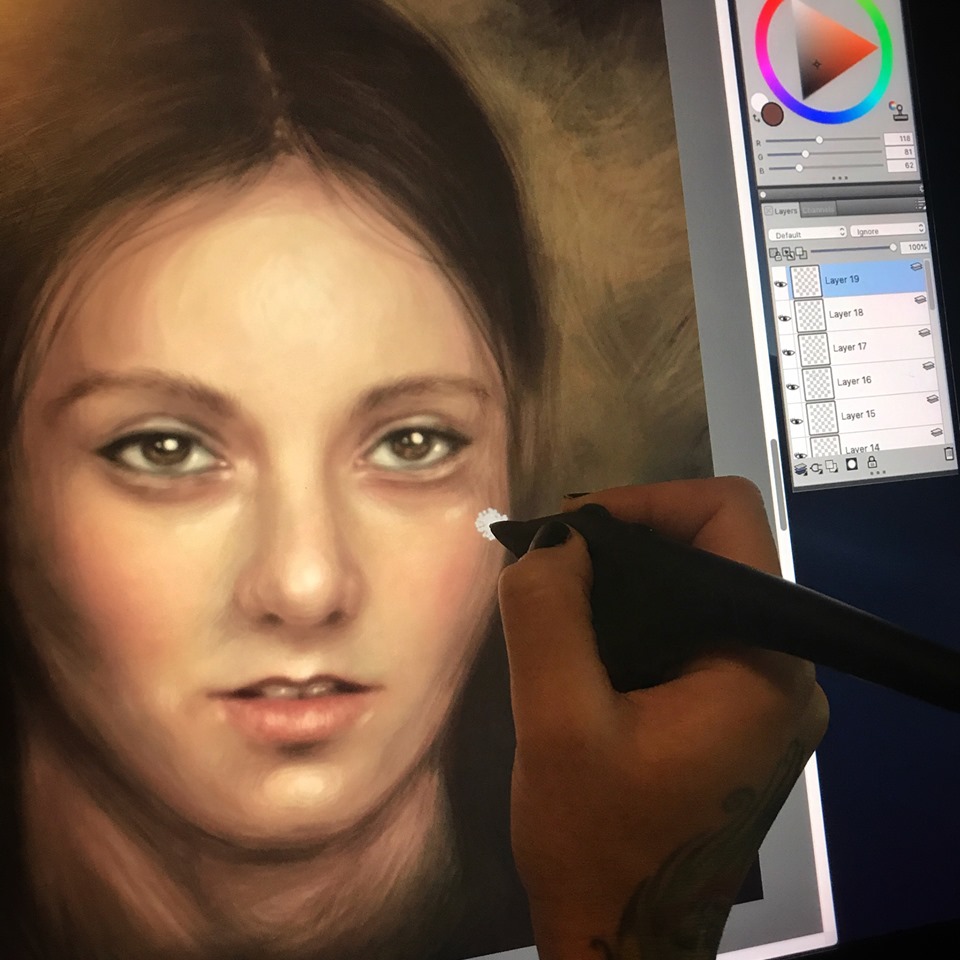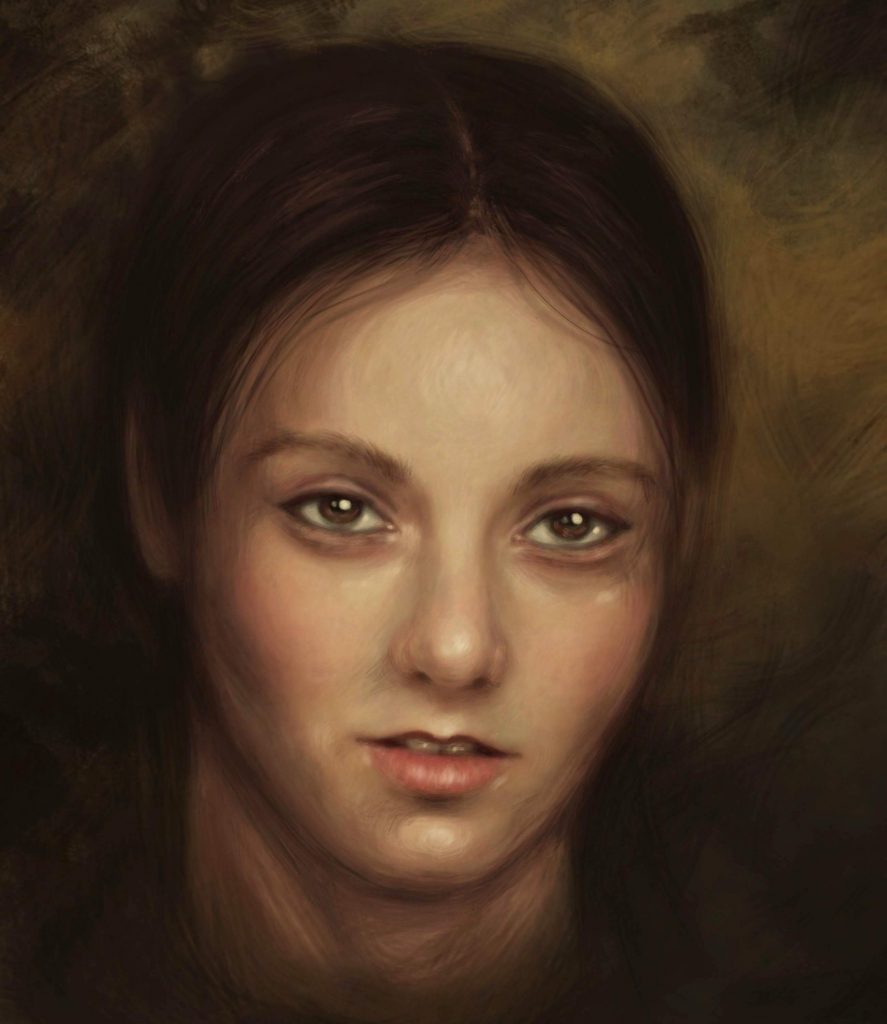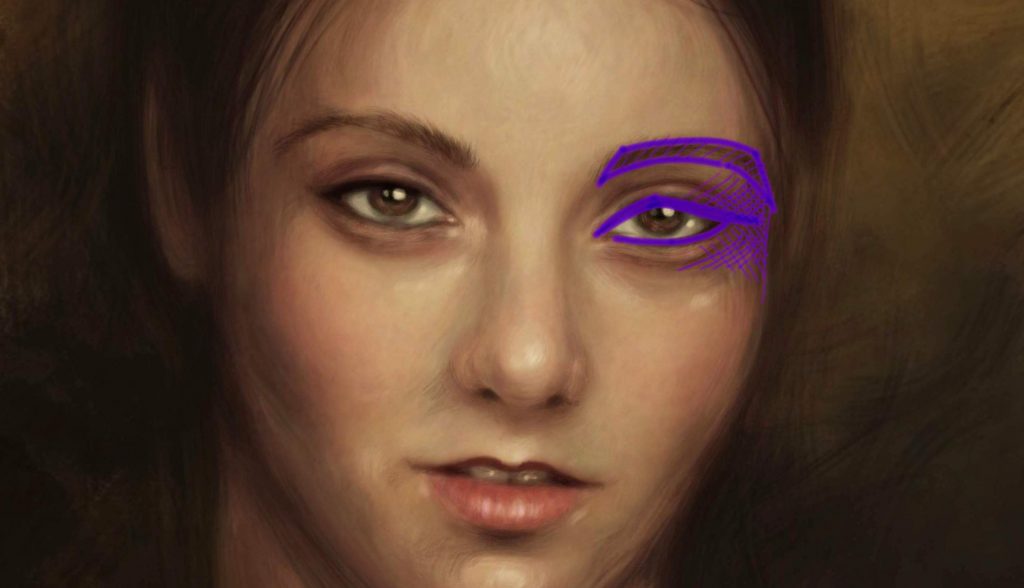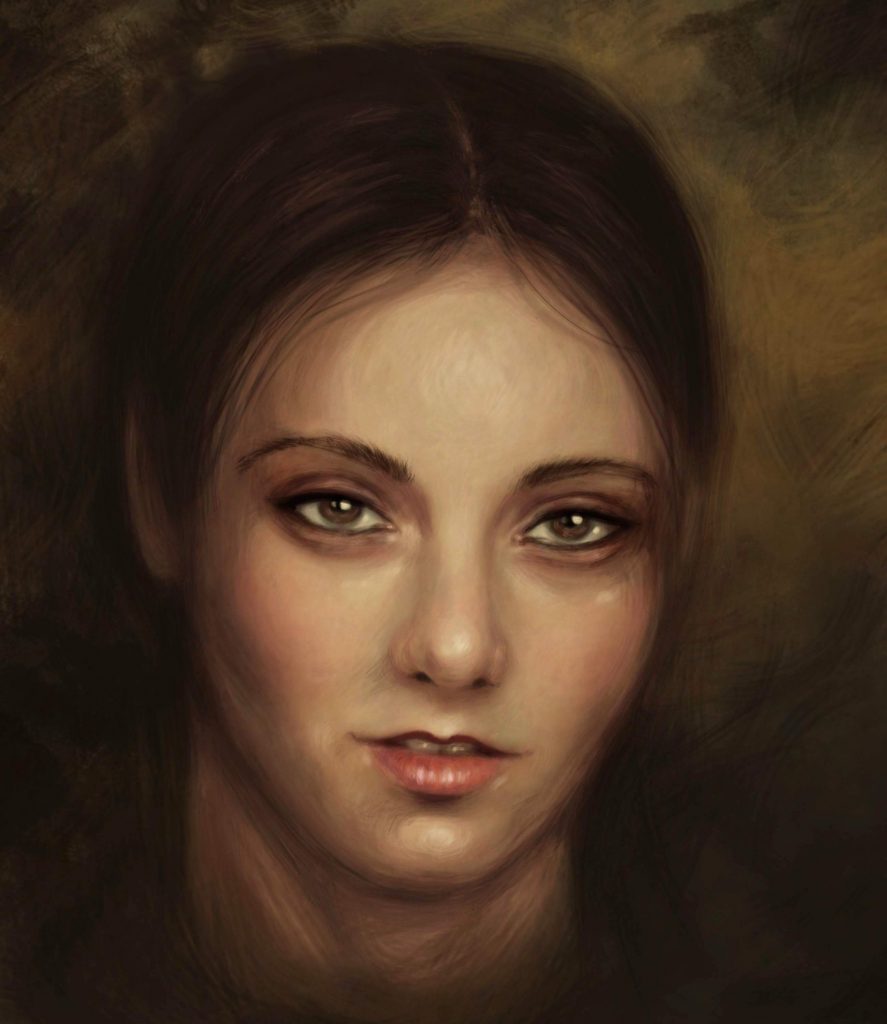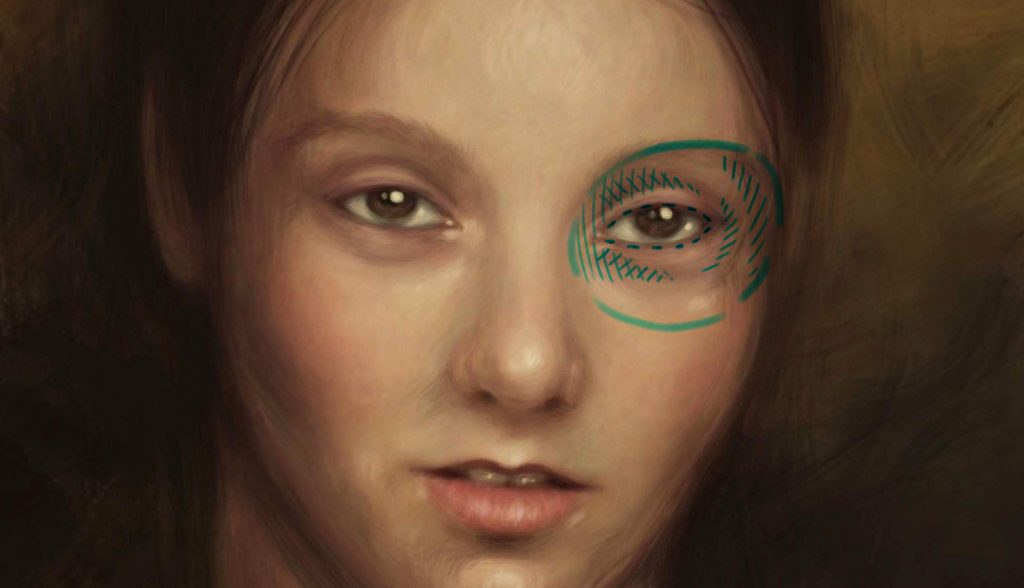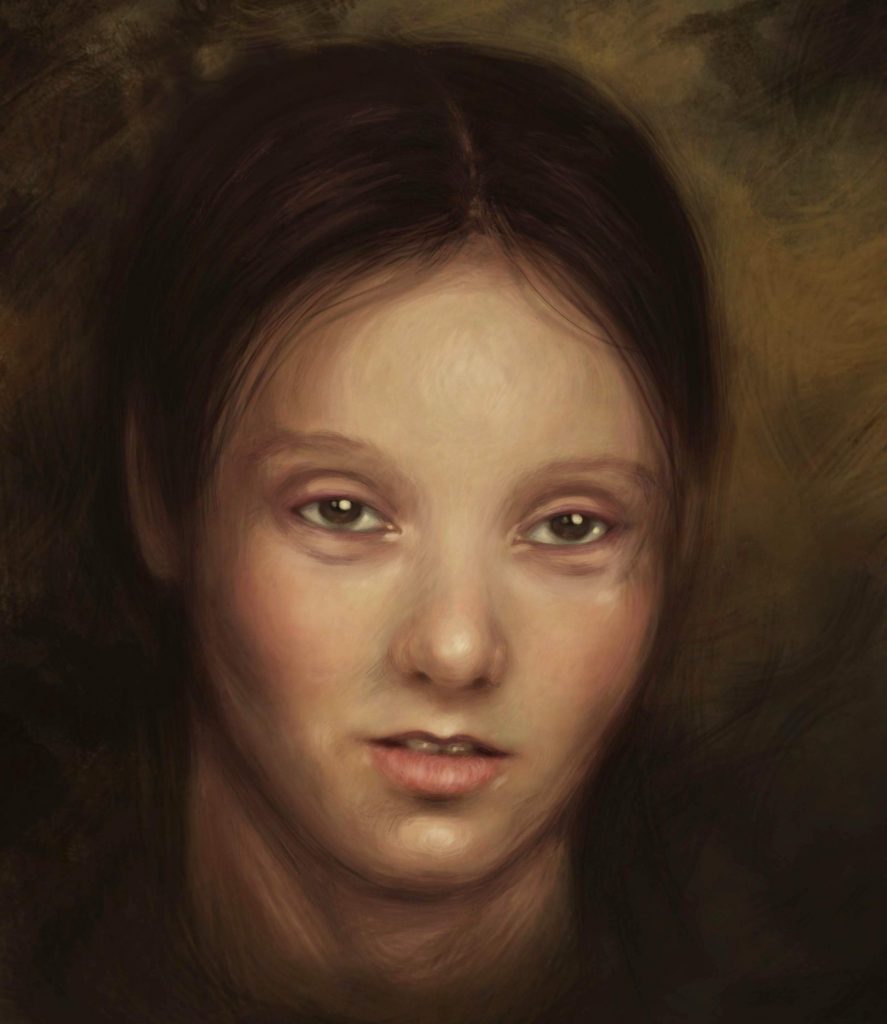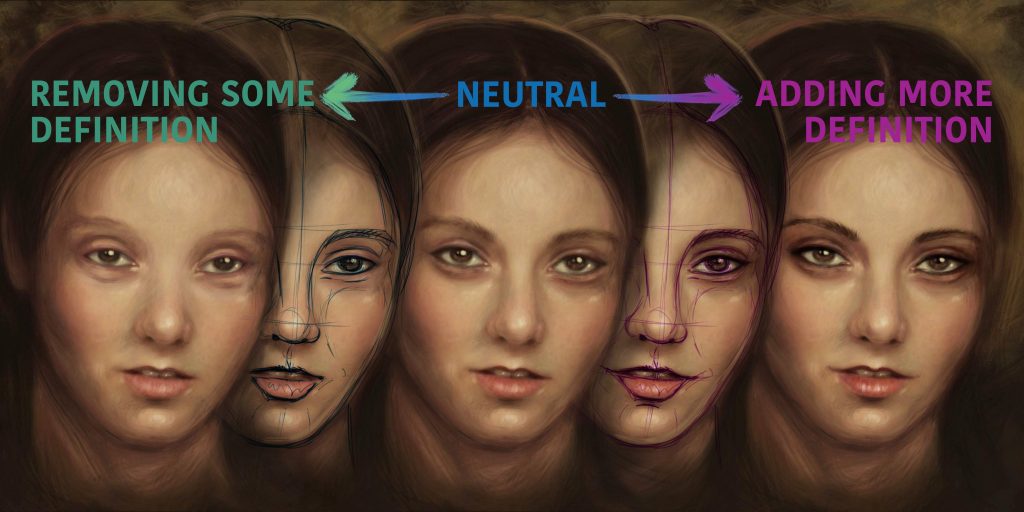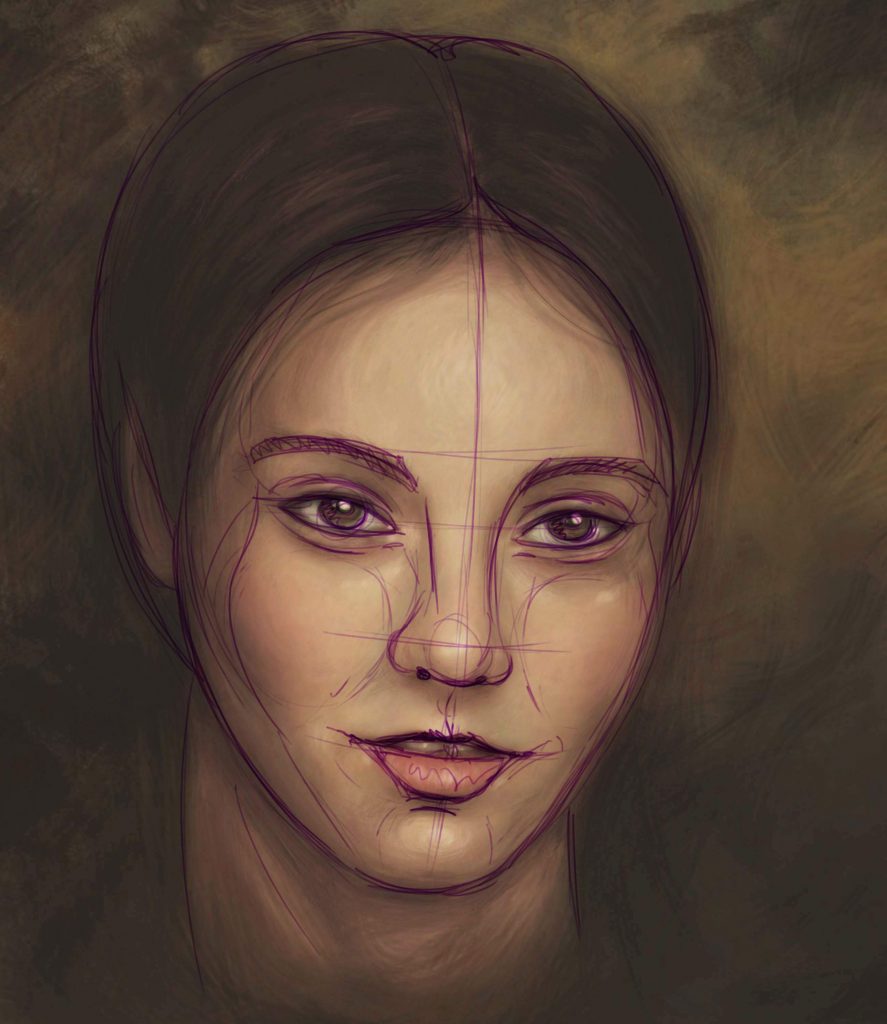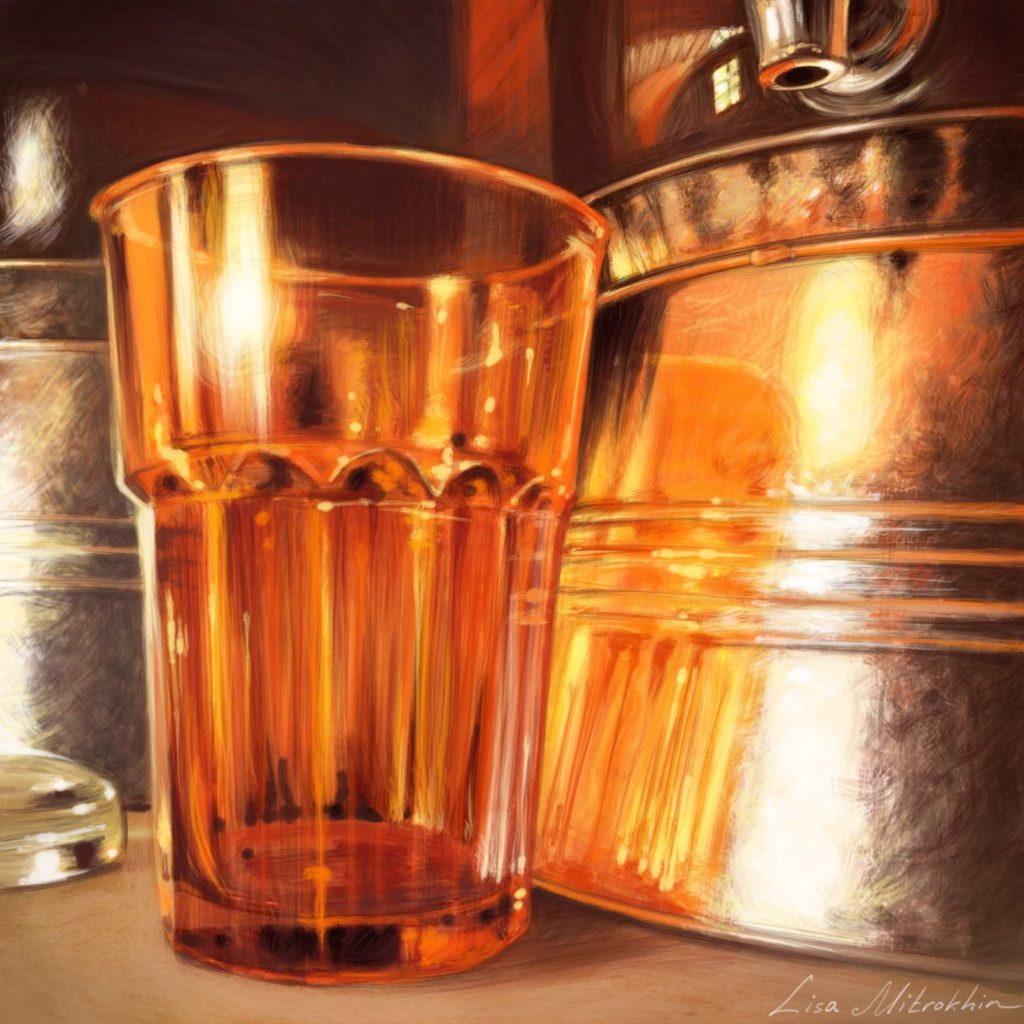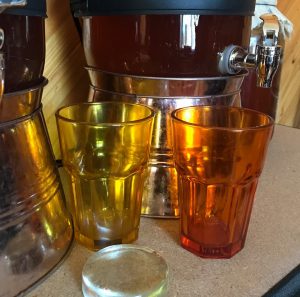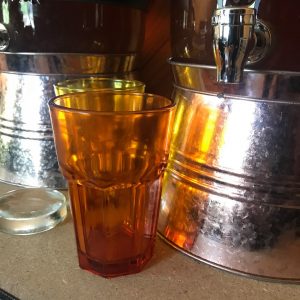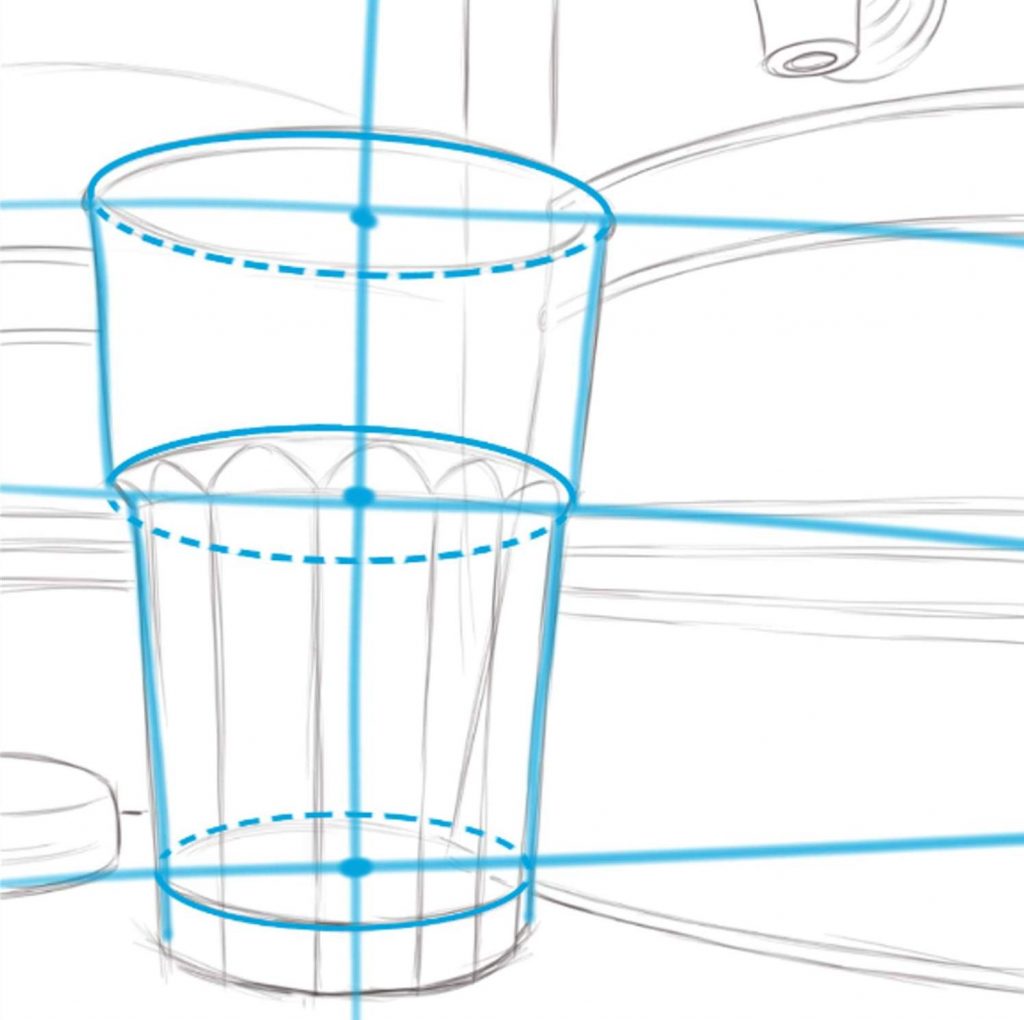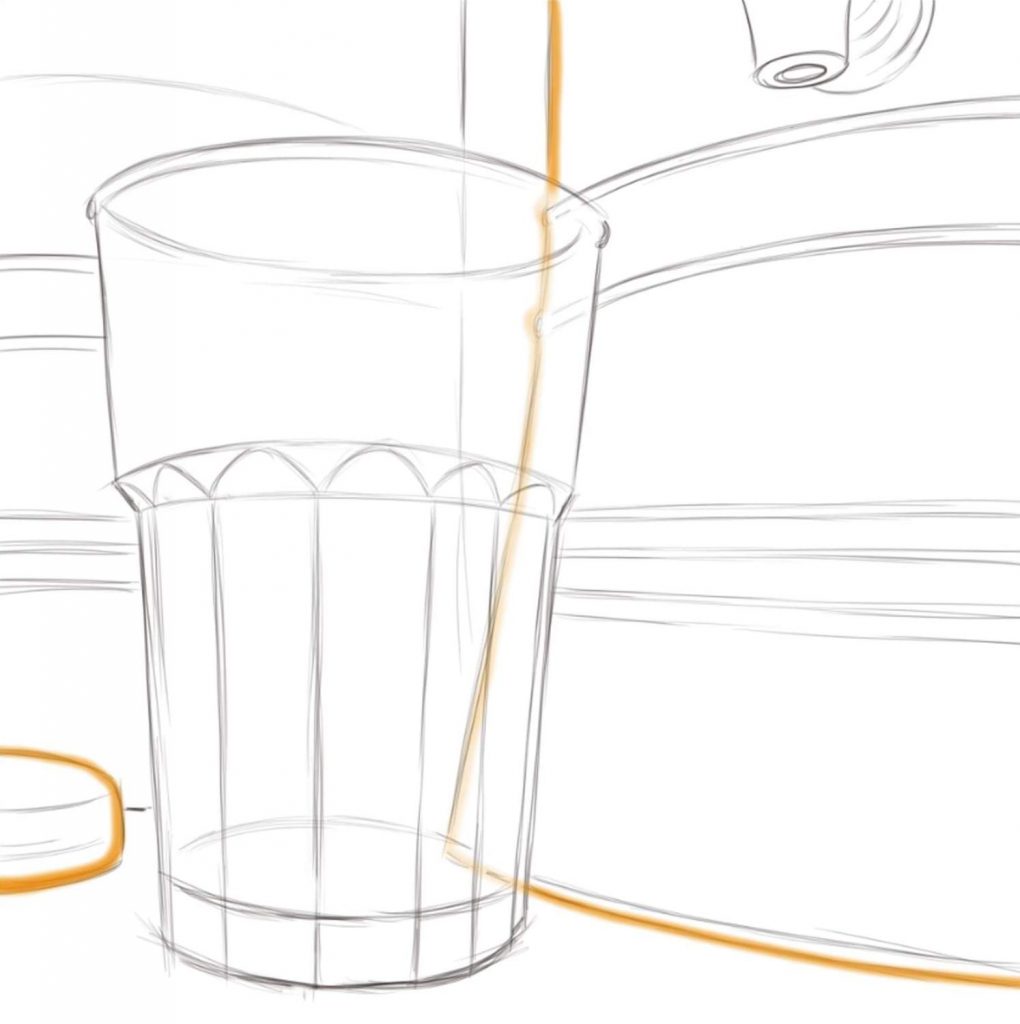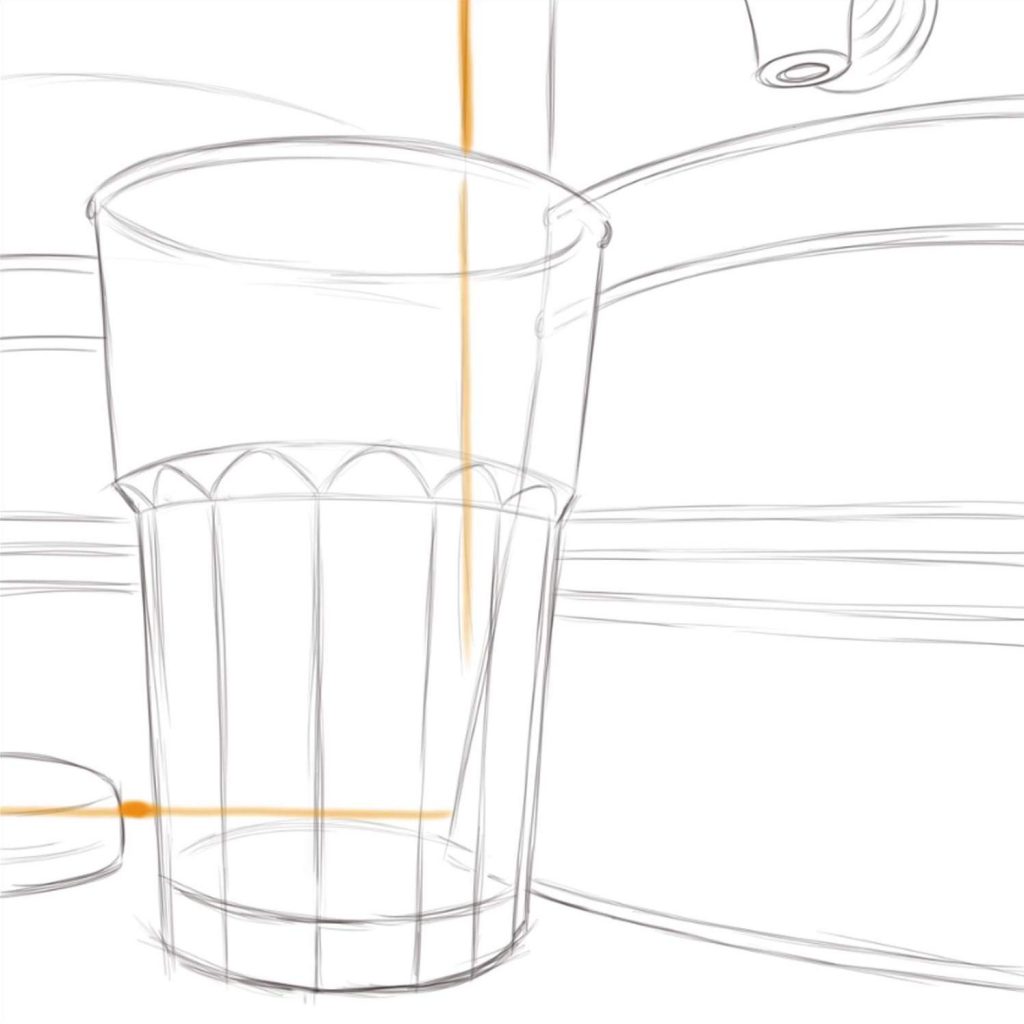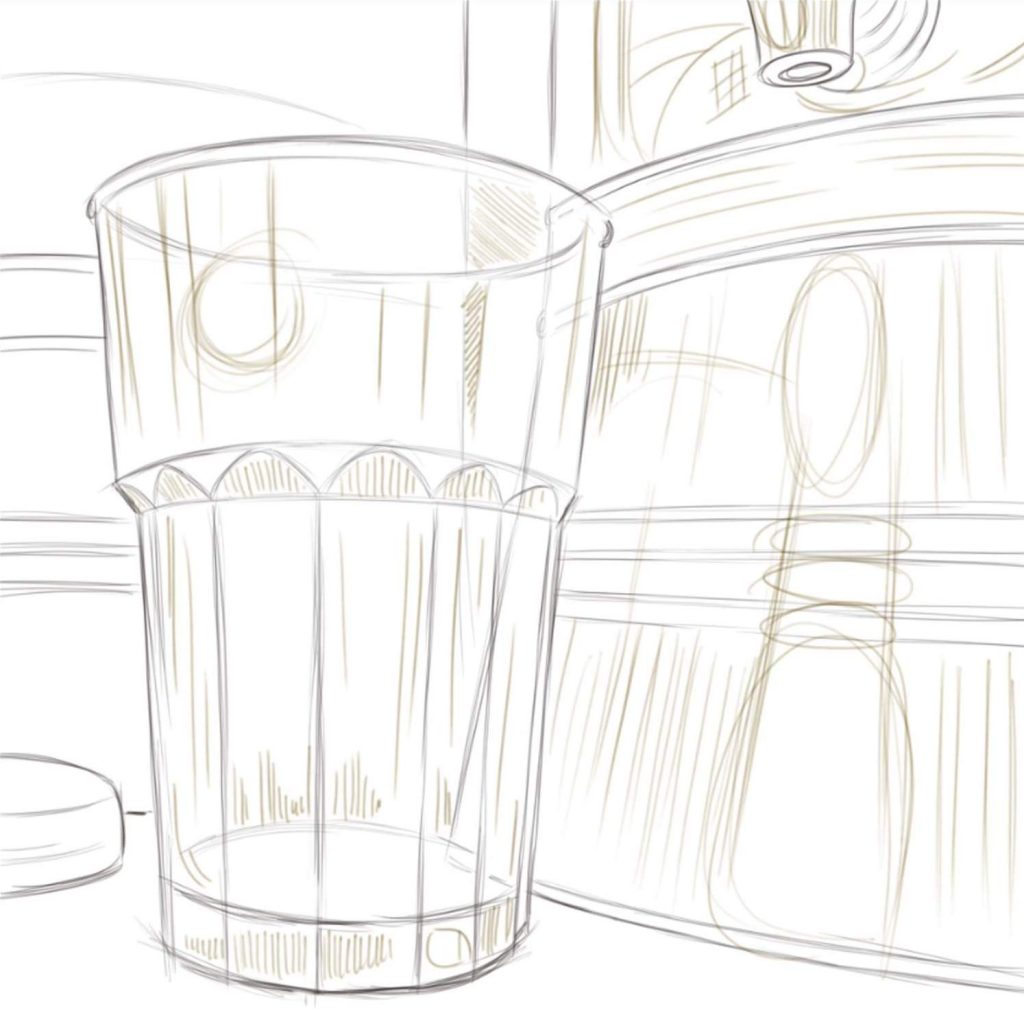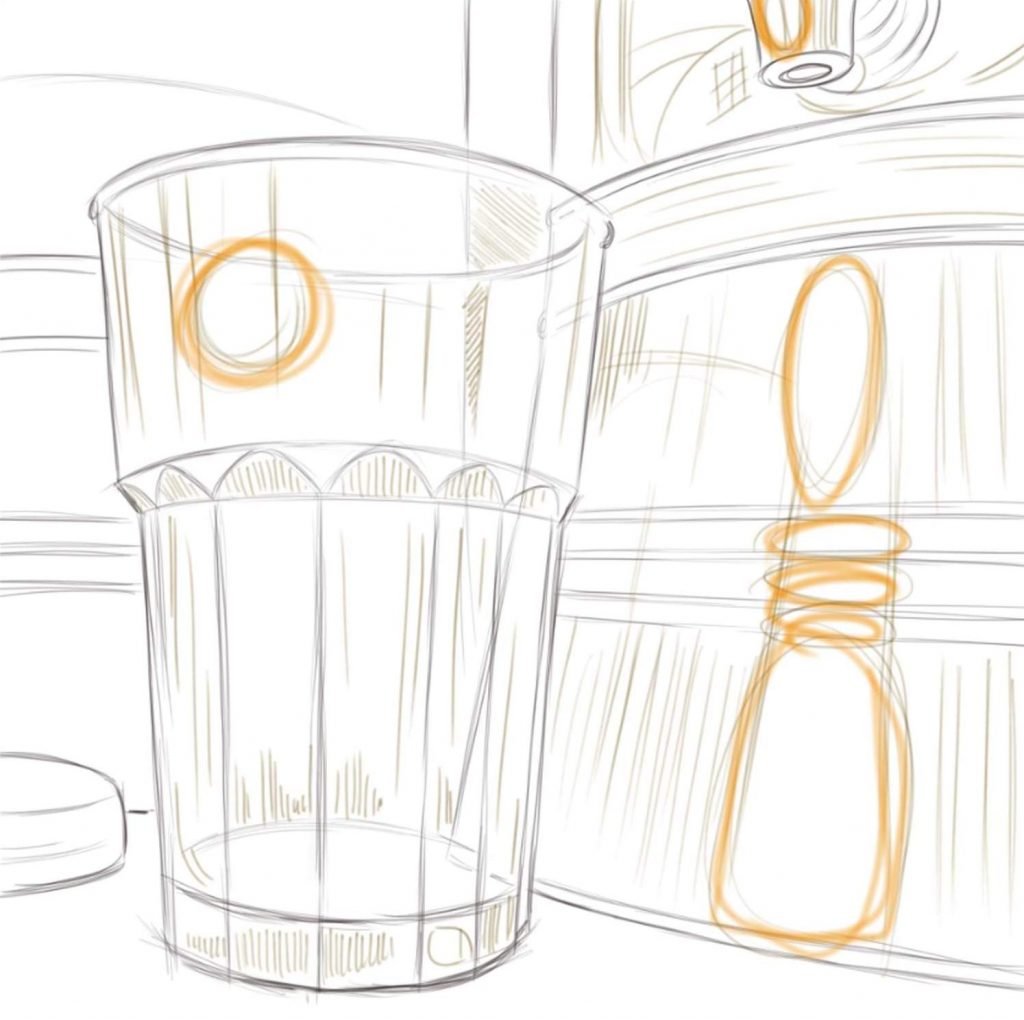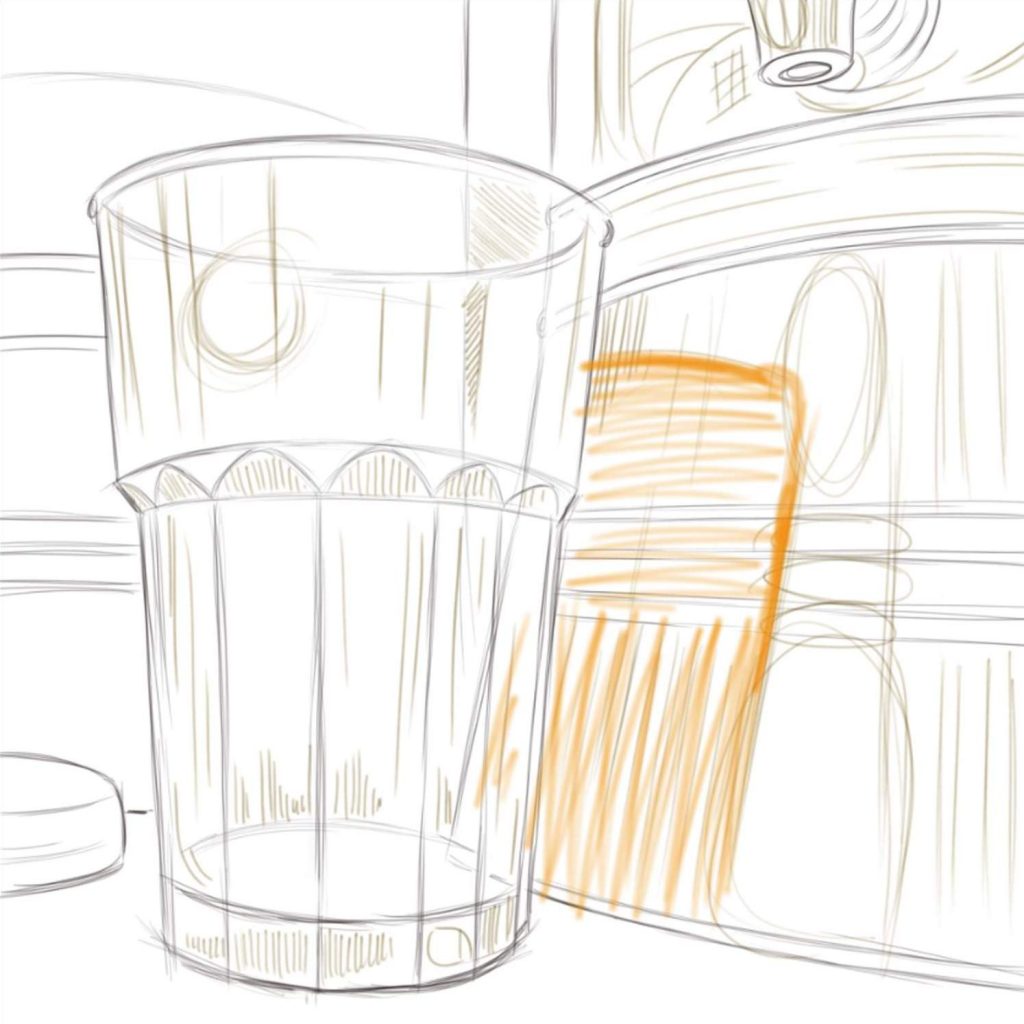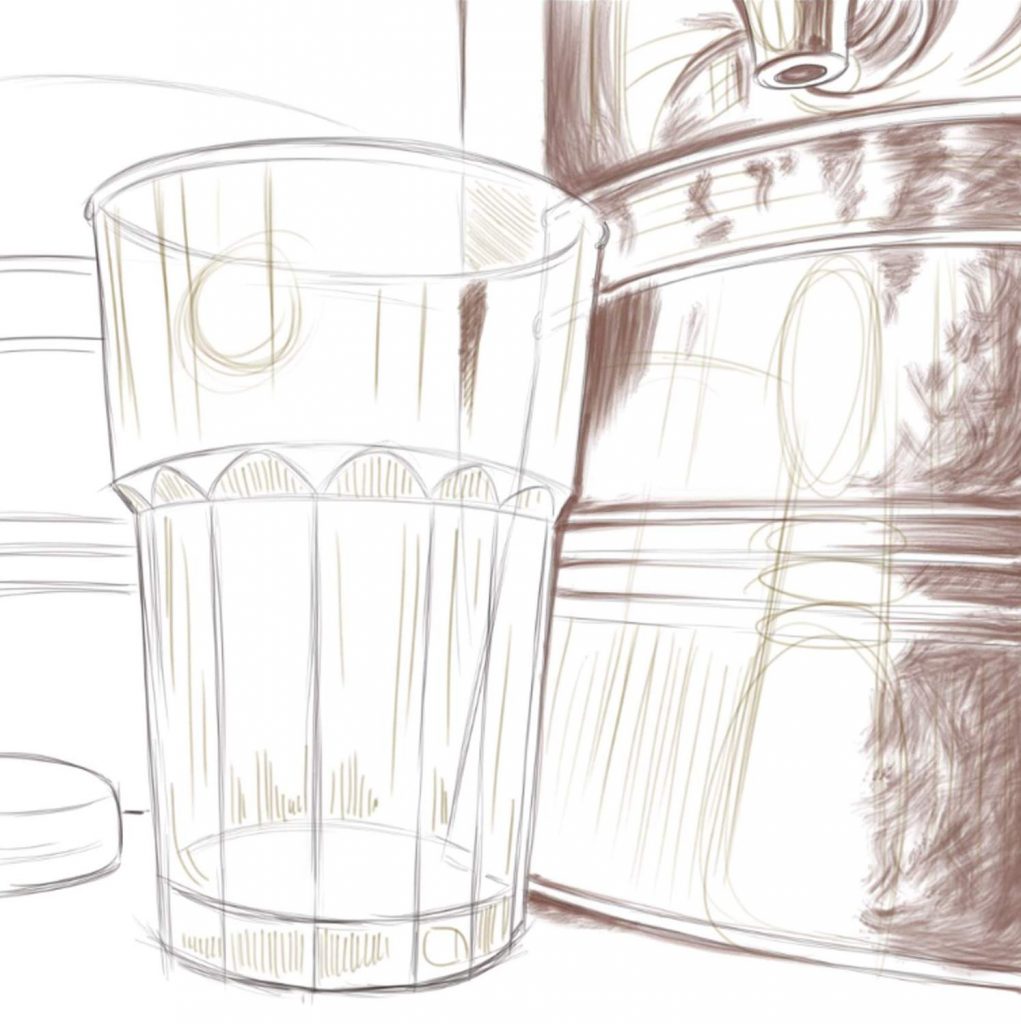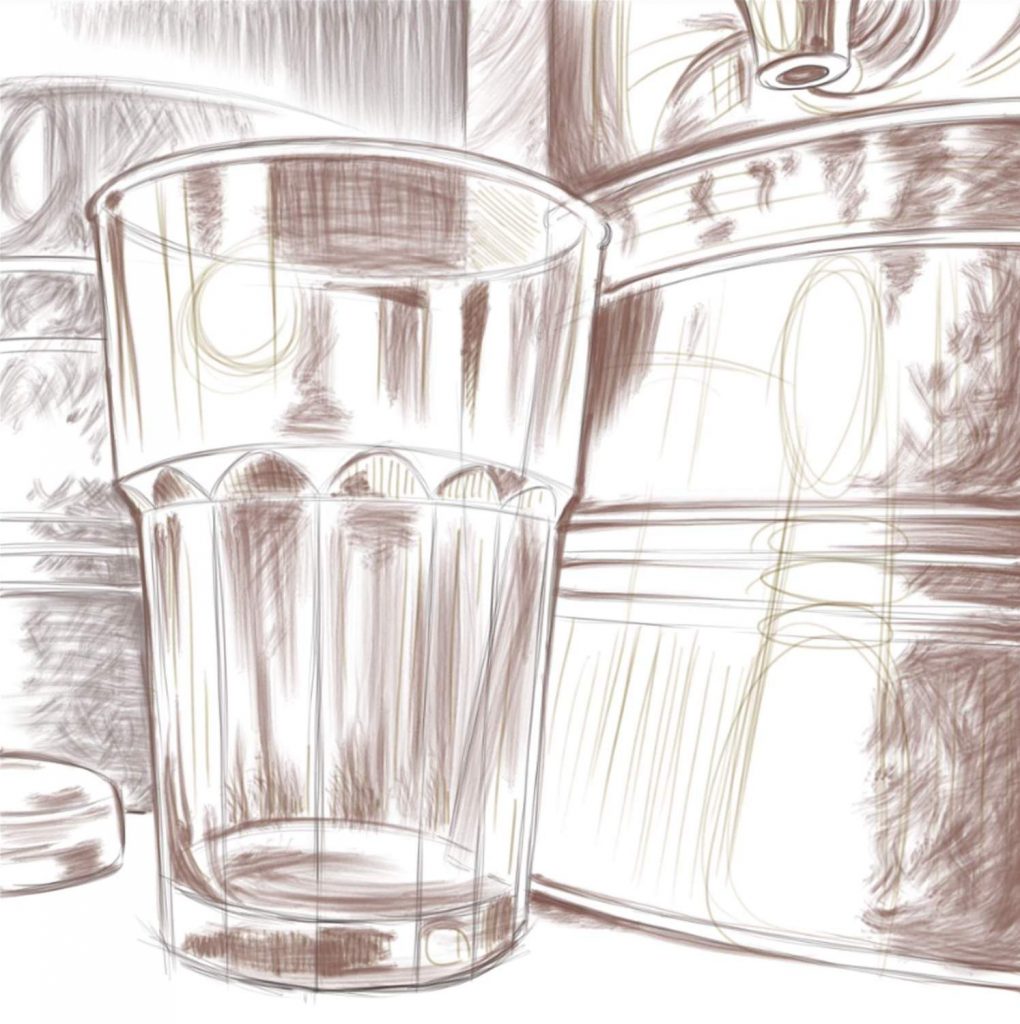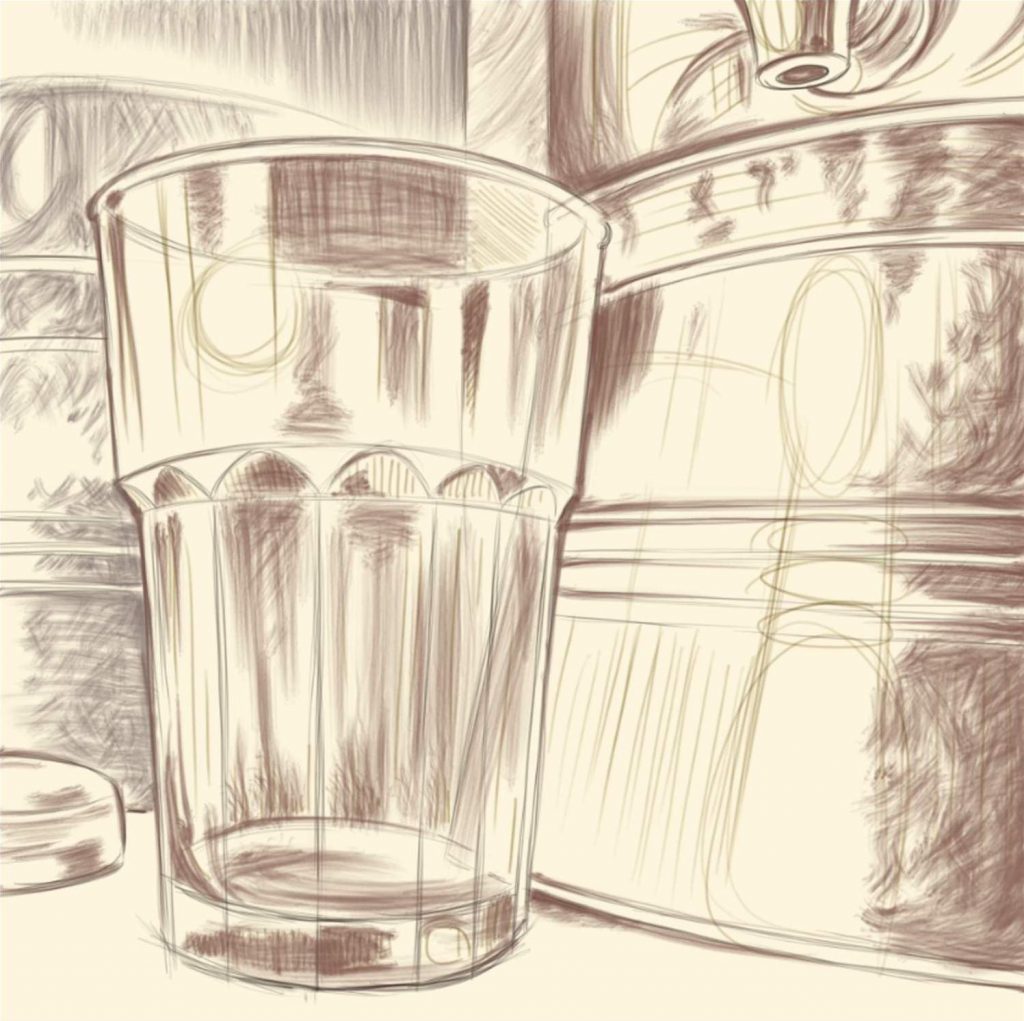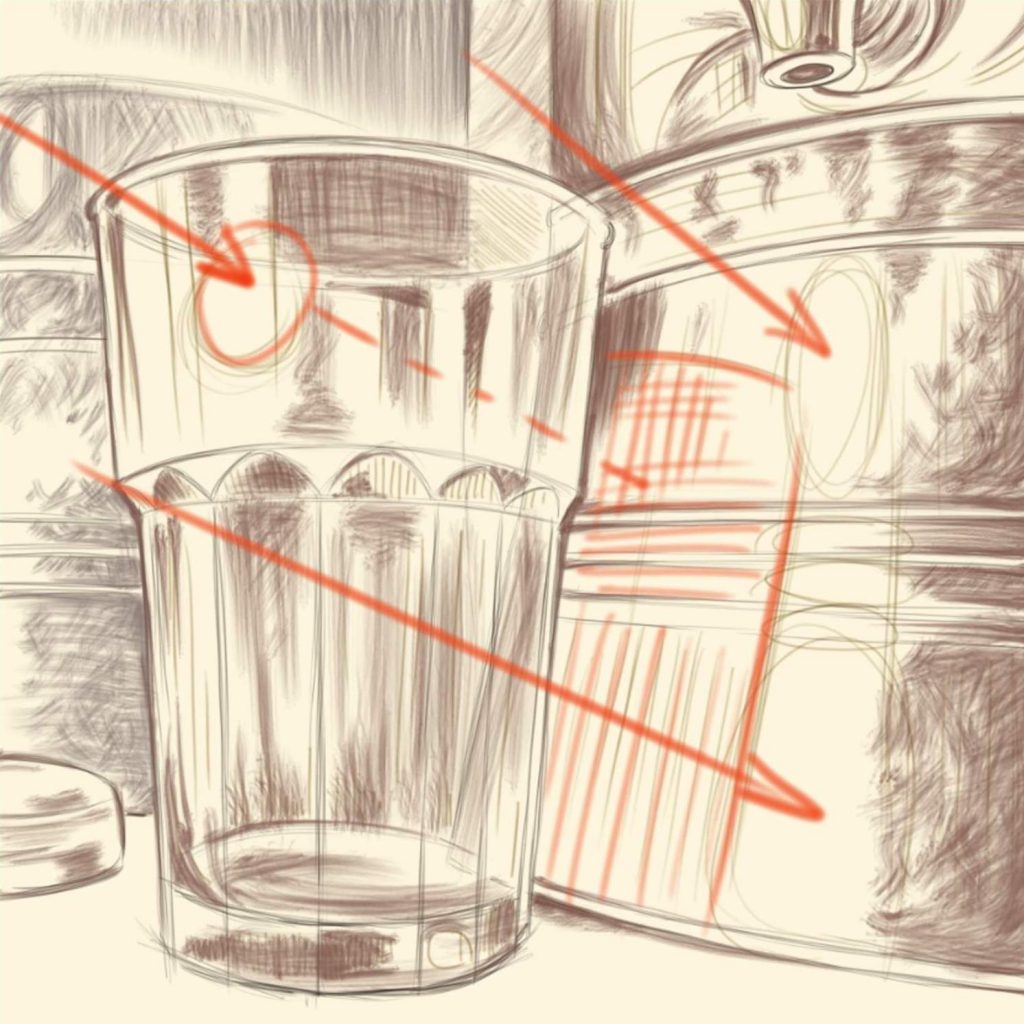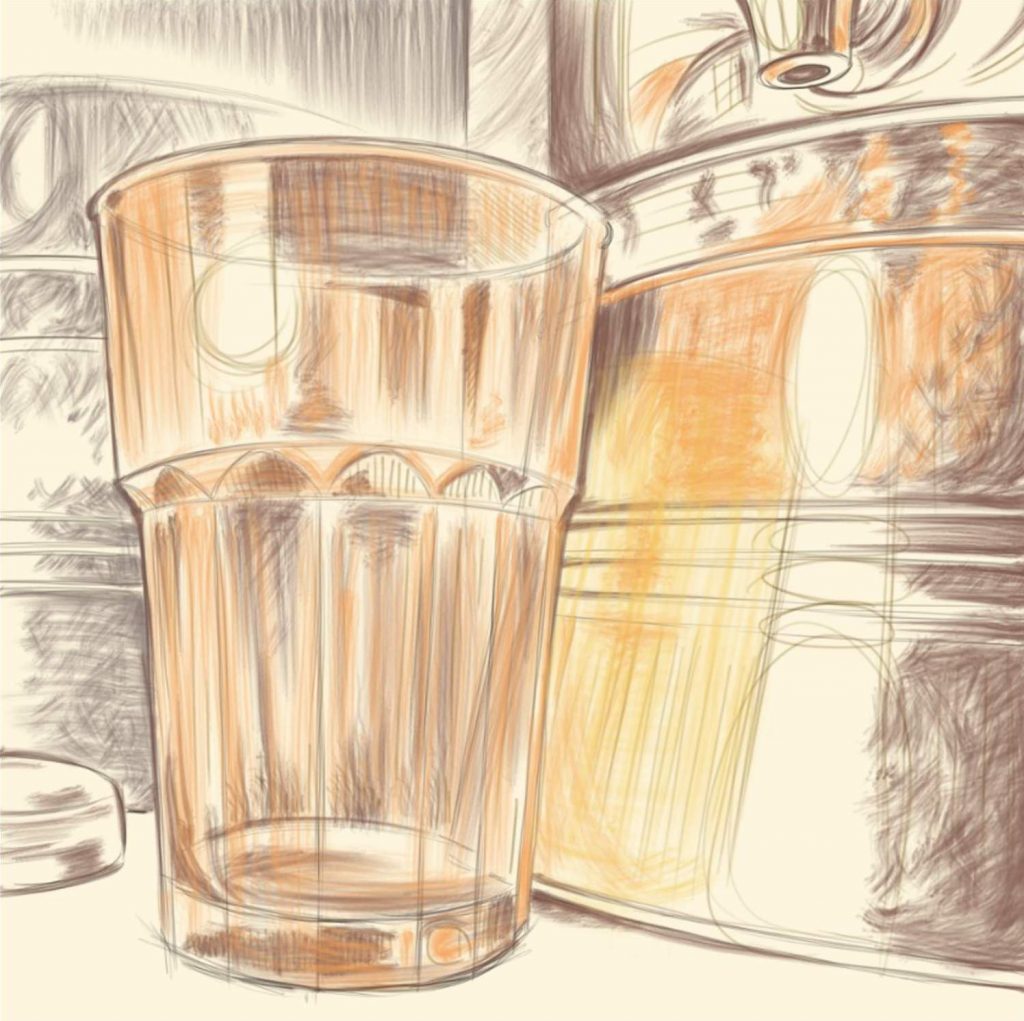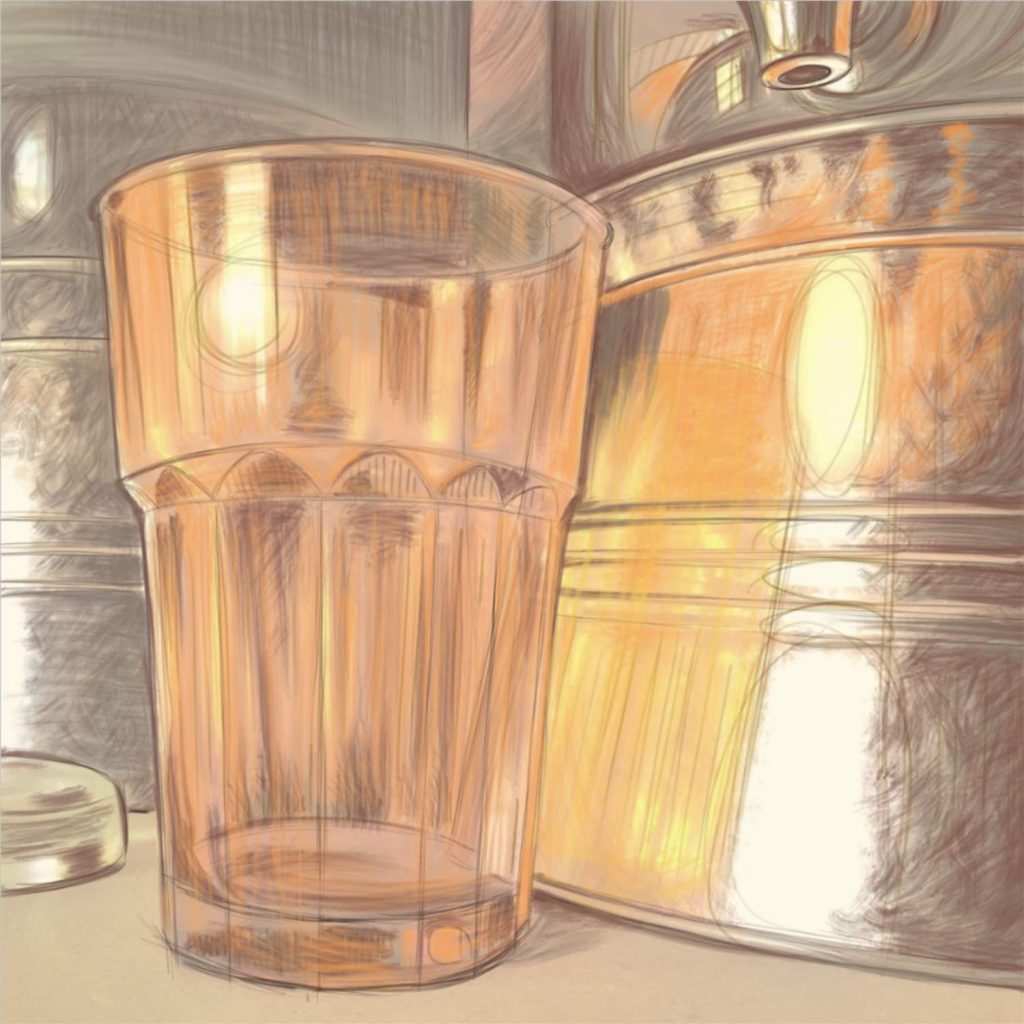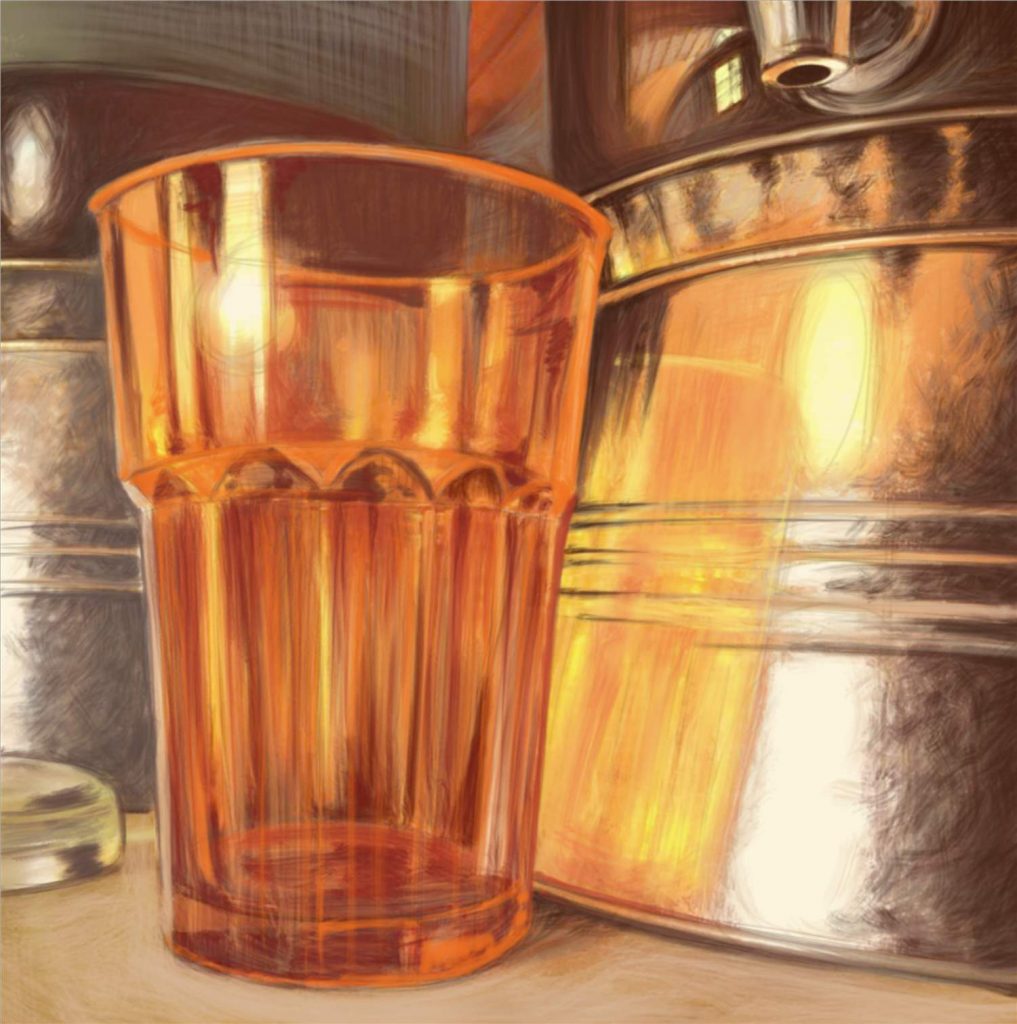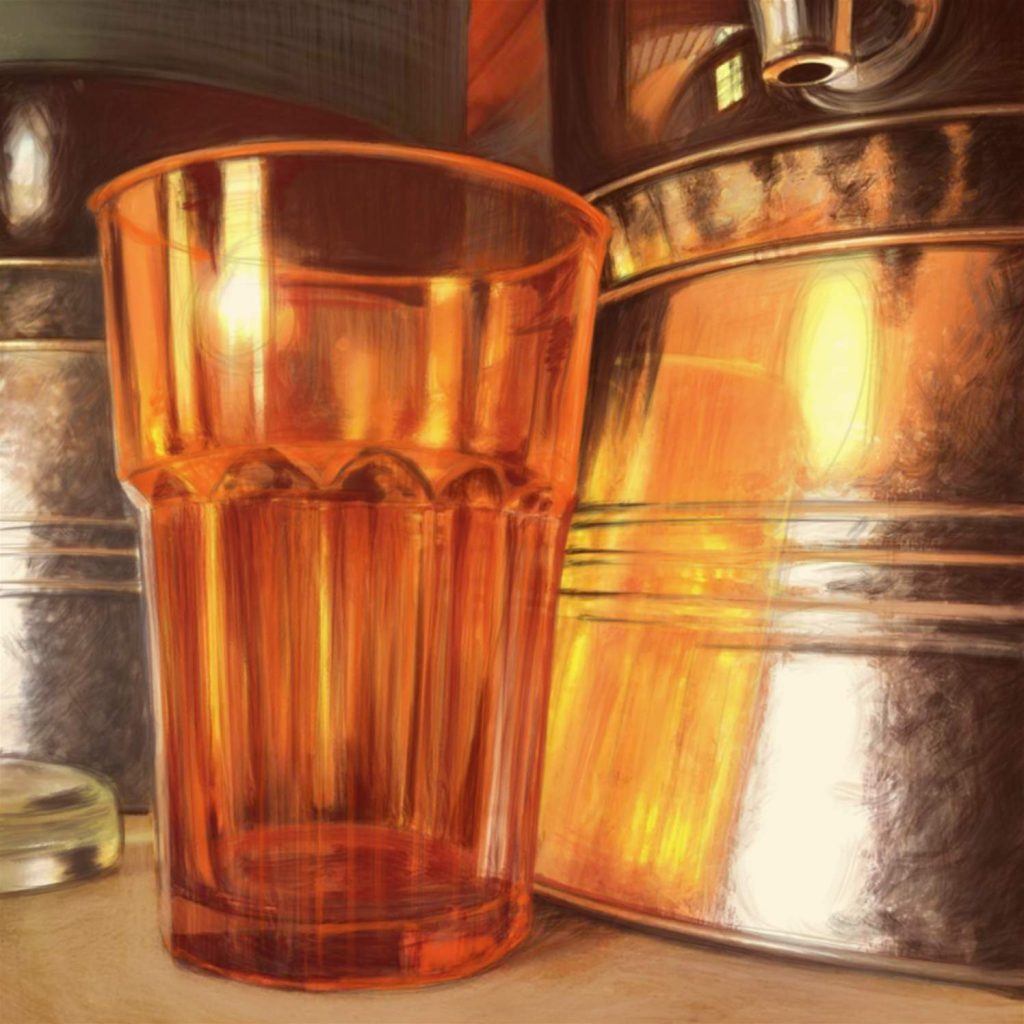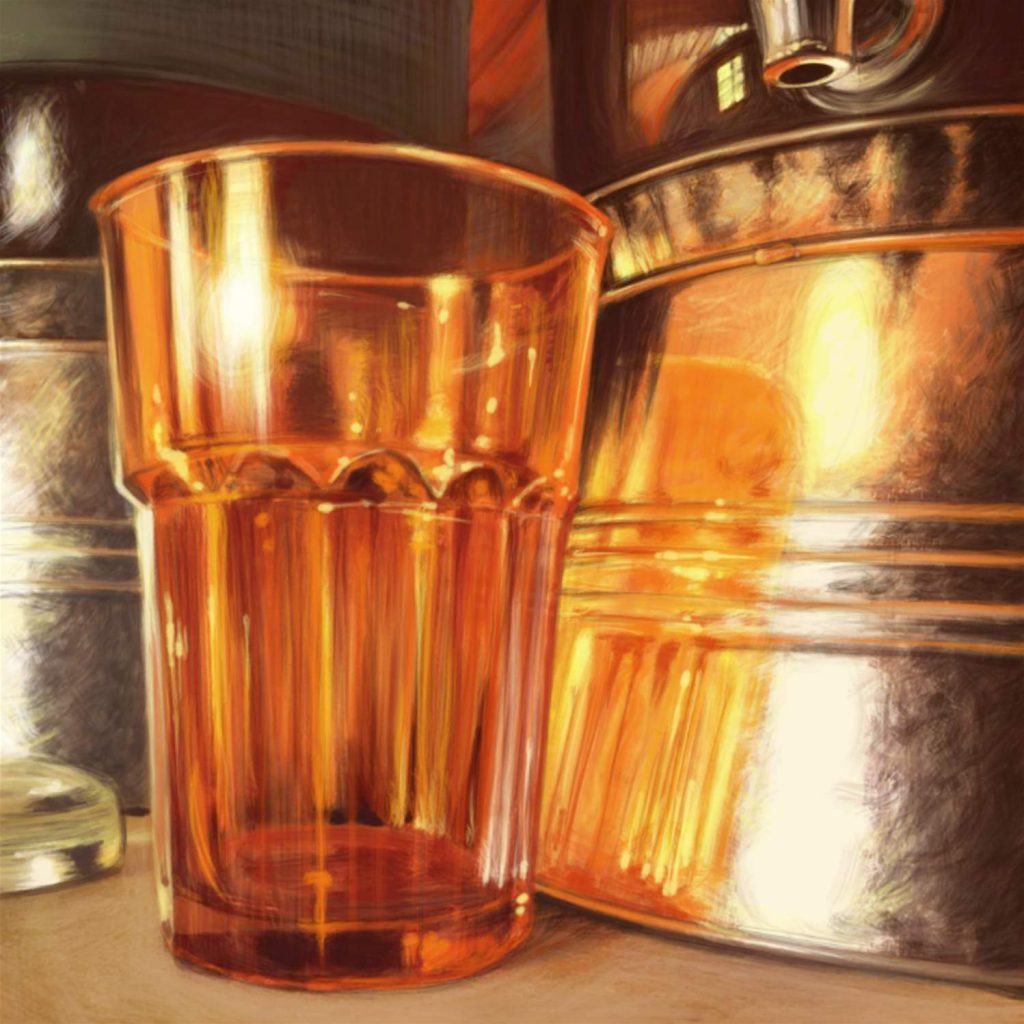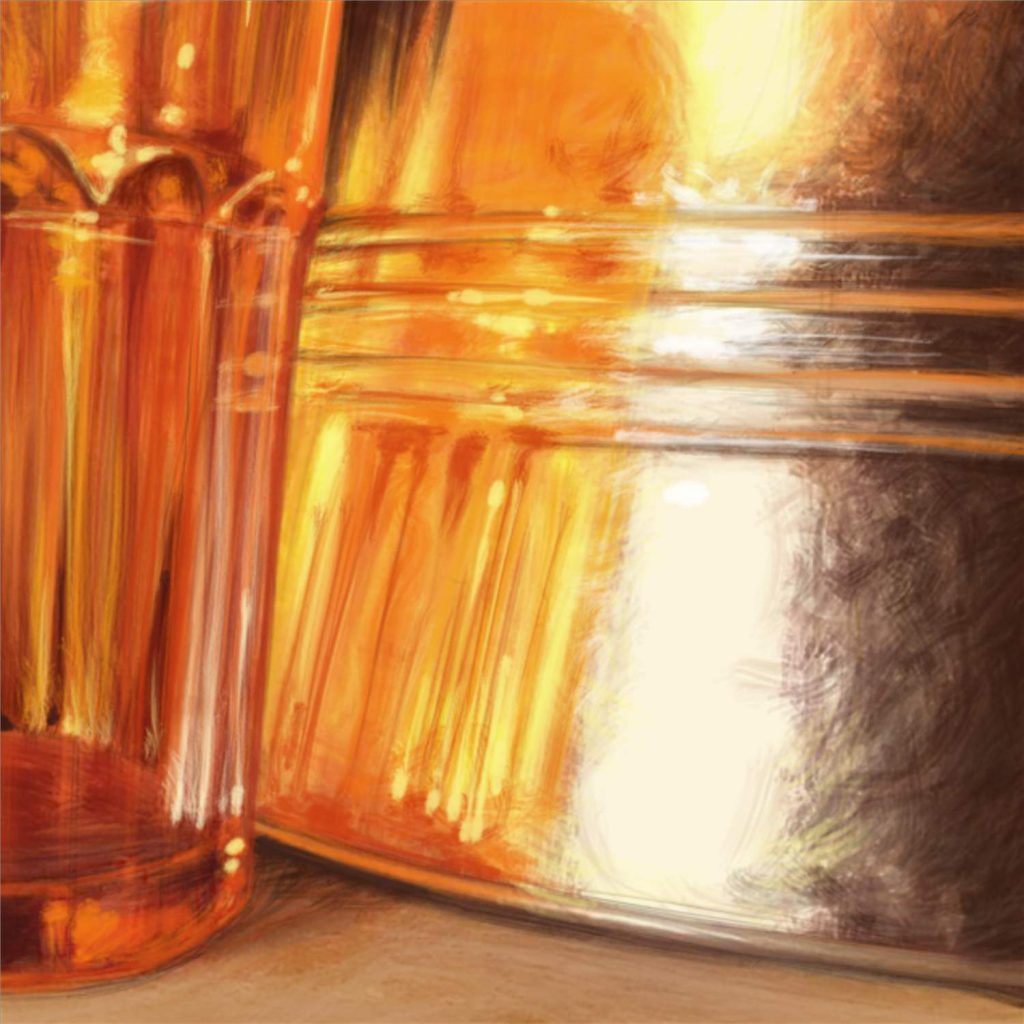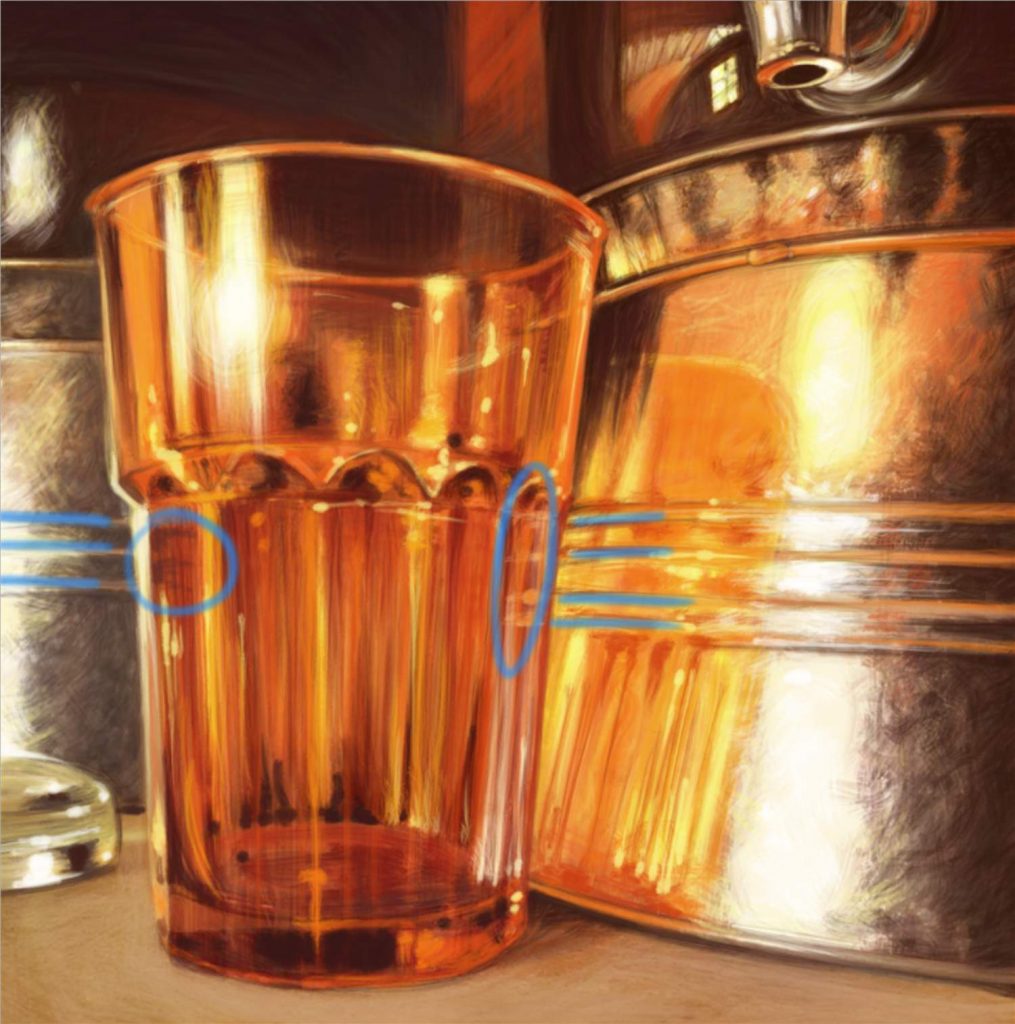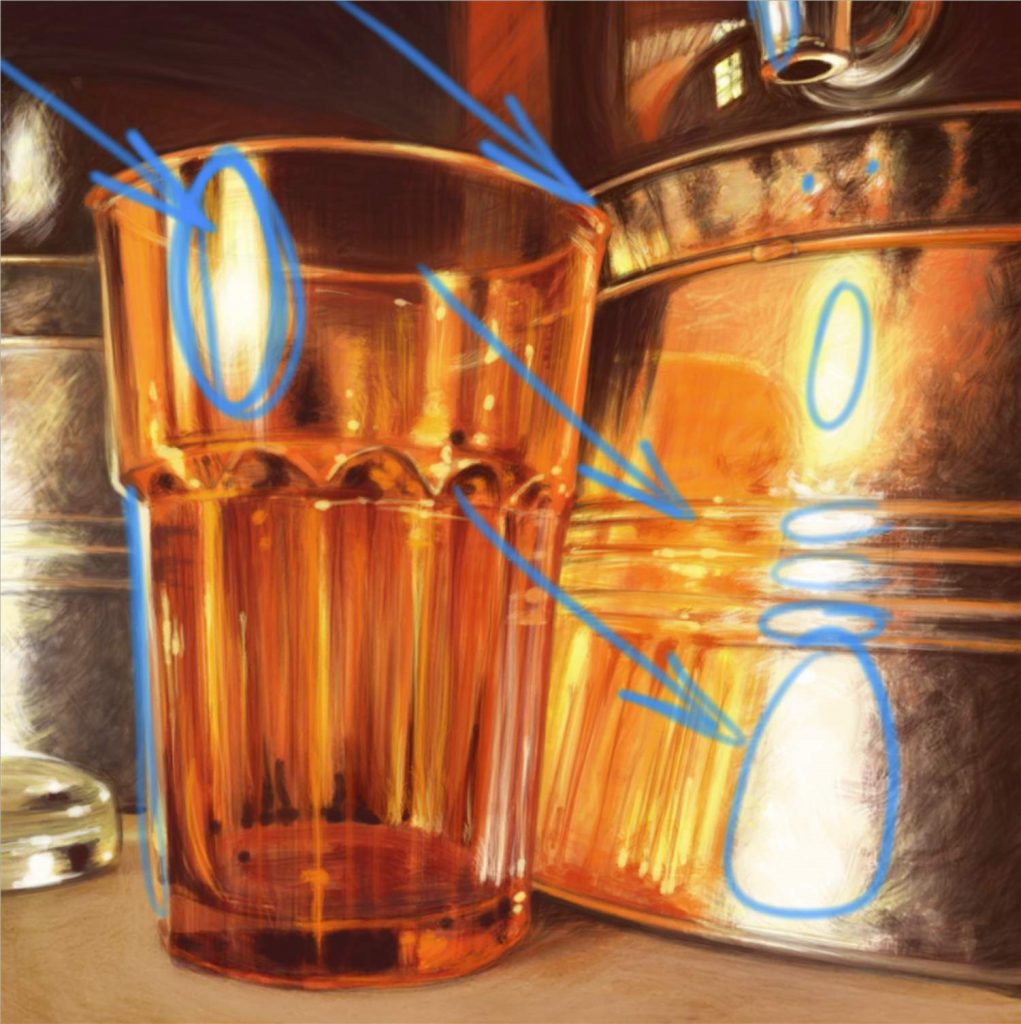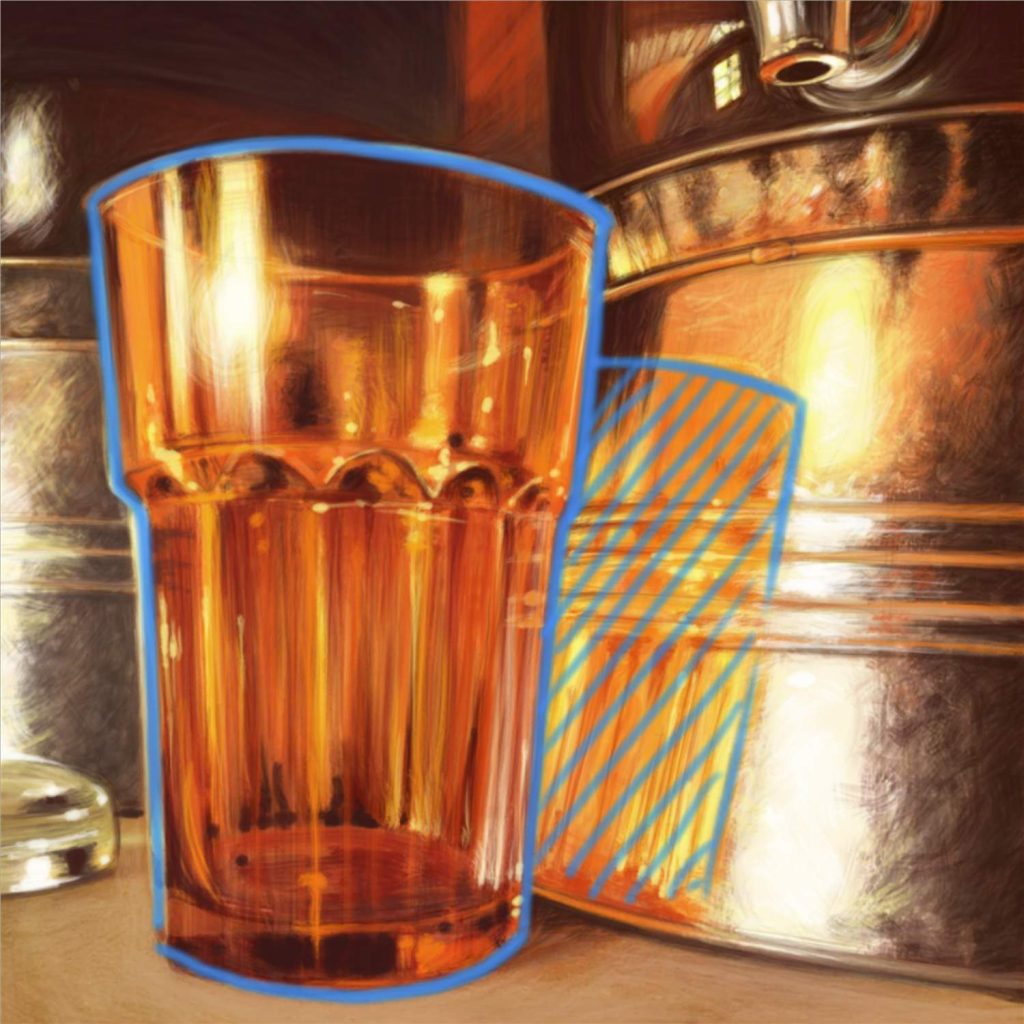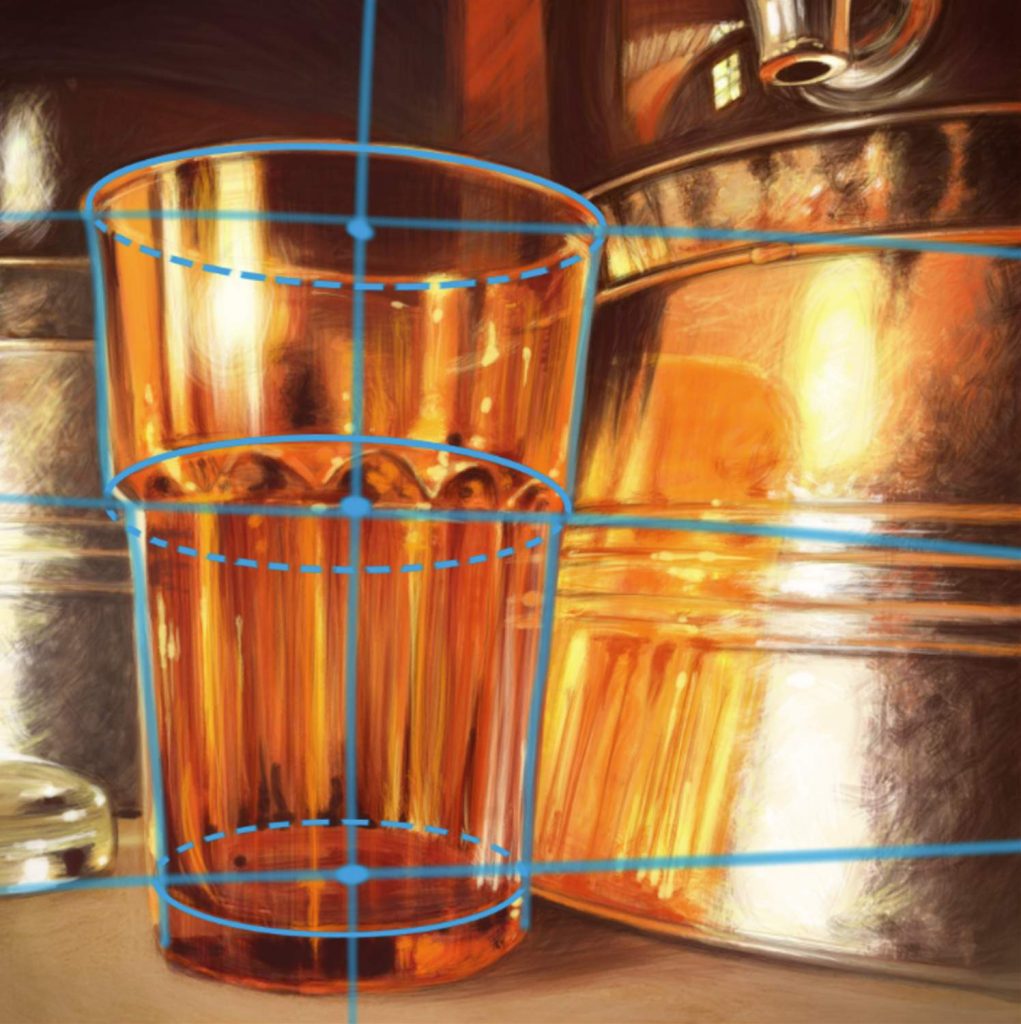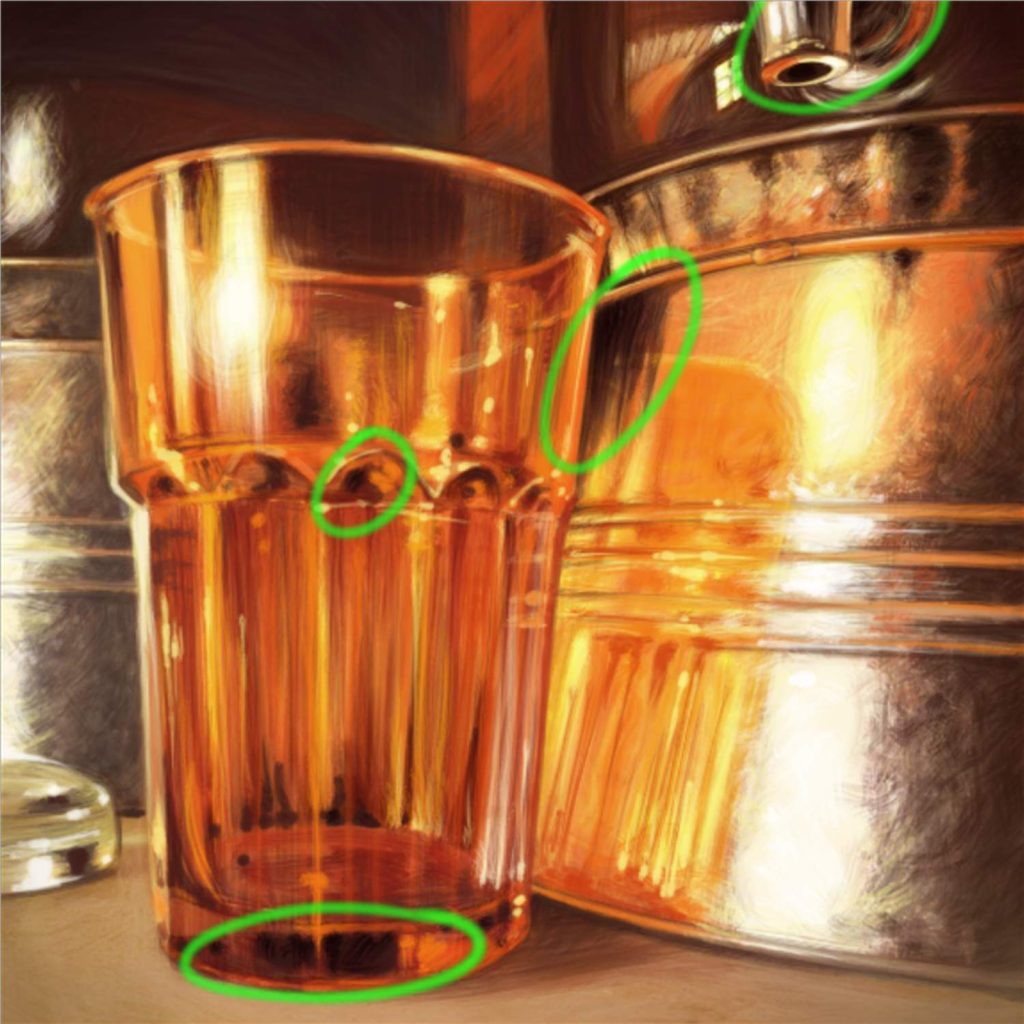In my art group TALM, I offer monthly coloring events. Each event is unique in subject, theme, and goal, and each always ends with one chosen winner. The winner of the event is rewarded with a unique prize. As a reward for winning my 5 de Mayo event, the winner got to request any tutorial topic from me on either coloring or drawing. She asked me to go over how I color feathers and bubbles. Excited by the unusual topic, I drew a coloring page of a winged angel in a bubble bath. It is this line drawing that we will be coloring today, paying particular attention to feathers and bubbles. Let’s get started.
I will be coloring this image digitally in Corel Painter, but the techniques I am about to apply are specifically tailored for color pencils. As a matter of fact, I will set my drawing tool to be the same types pencils as I would use in real life.
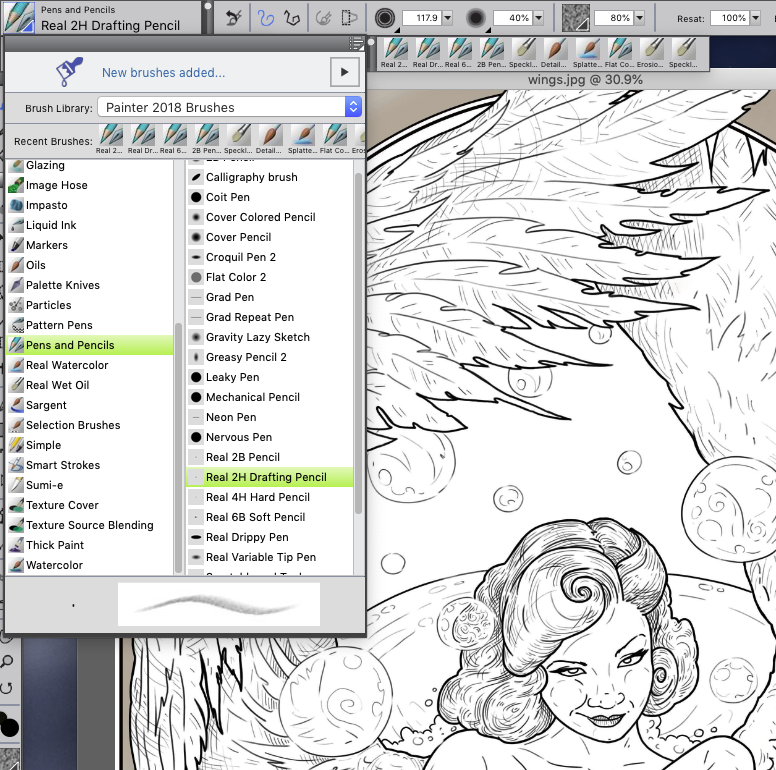
My pencil settings in Corel Painter
Because we are focusing only on feathers and bubbles, I will skip the step by step portion of how I colored the angel’s body. Let’s just jump to the part where her skin and the details of her face are already done.
The order in which you color the subjects of the page is very important. I would not start with the wings and I would most definitely not start with the bubbles. Here’s why. The wings are an accessory to her. We need to know what she looks like first and then decide what kind of wings match her complexion. The bubbles should be the last thing to color because they are opaque and transparent. They reveal and reflect all the colors of the scene. How can you possibly know what color your transparent bubbles should be painted if you didn’t yet paint the scene?
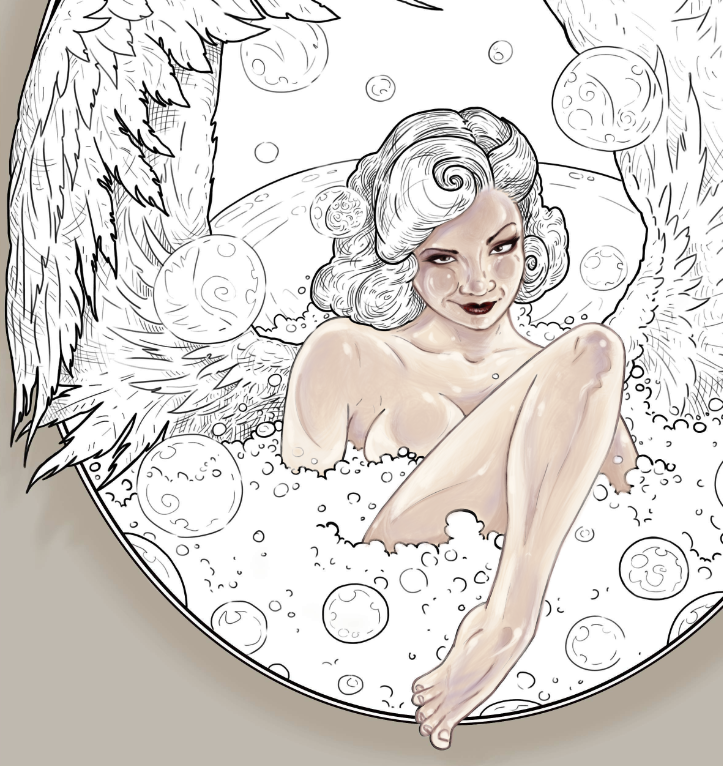
We skip to the part where the body and the face are already colored.
The next part that I like to establish is the background. This will set the mood for my overall color scheme. Many people leave the background for last, but I find that in most instances that is not the best way to go. Establish your settings and your atmospheric conditions first, and then the colors and the lighting of your main subjects will be established for you.
In this case, I want the scene to be soft and dreamy. I pick very delicate pastel tones of lilac. I may adjust them later on, but for now I am happy with this color. Notice how I didn’t just click-and-fill the space. I took the time to actually color it with my pencil tool, giving it some blurry swirl effects. Whether you are working digitally or with physical pencils, try to avoid solid color backgrounds. That makes the backdrop look flat. Instead, try to suggest some atmospheric perspective with blurry effects and using several similar tones instead of one solid color. When working with pencils, blurry effects can be achieved by smearing and smudging your pencil marks with q-tips, soft erasers, cotton balls, and even your finger.
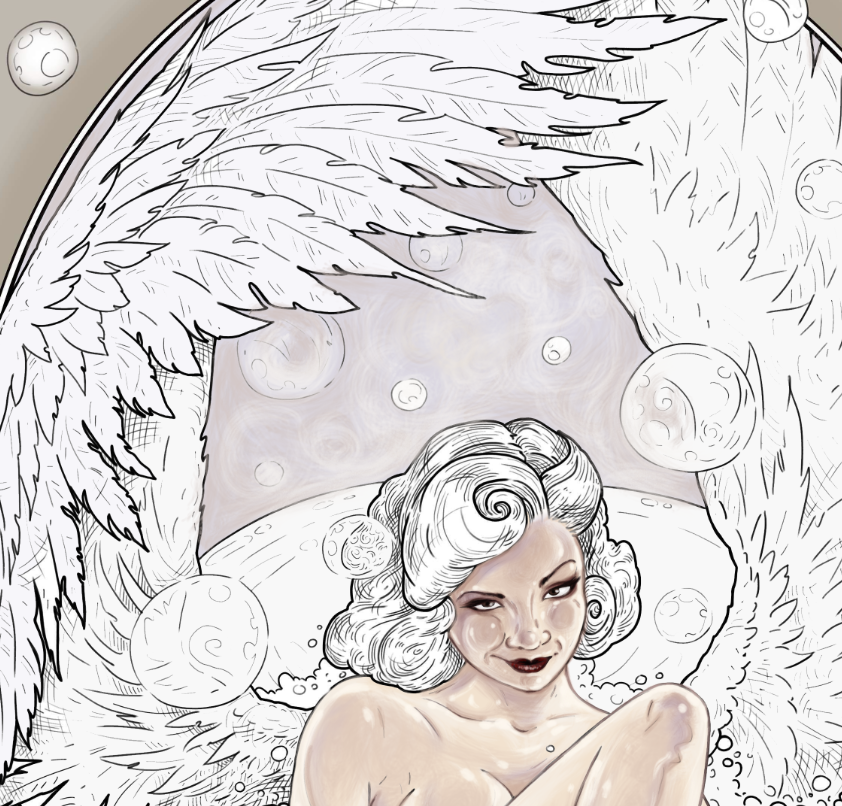
I have a very clear idea in my head of what color scheme my finished drawing will have in the end. I can close my eyes and literally see the finished piece. When I draw, paint or color, I am actually just reproducing what I already see in front of me. Many people don’t approach drawing and coloring this way, and that’s perfectly fine.
If you cannot clearly see the finished colors or have difficulty deciding what color schemes to use, I highly suggest using what I call inspiration pieces. It’s simple, especially now that we have a world of images at our fingertips. Just look through a whole bunch of images until you see ones that speak to you in terms of light and color. A good idea is to search for various types of photography, and just let the image links take you down a rabbit hole until you come across color palettes that you like. Keep in mind, these should be completely unrelated images. They can be paintings, photographs, screensavers, whatever strikes your fancy. As long as you find pictures in color schemes that look beautiful to you. Pick one and use it as a guide when selecting colors for you piece.
Here are some examples of photography that I found online that are interesting to me for some other projects I have roaming around in my head. Remember, we are only looking at colors and their distribution on the page, not the subject matter. There are literally millions of images out there. Take a a few minutes to look through some of them to find the color inspirations that work for you.

Examples of photography that I found online.
Ok. Let’s continue. Now that you, hopefully, have an idea of your color mood, let’s get those wings painted. I want her wings to be almost white. Not quite perfectly white, but kind of cream-colored. I begin with some very basic grey shadows.
The most common mistake that people make when coloring wings is focusing too much on each individual feather, and losing track of the structure of the wings. Don’t start with feather details. Instead look at the wings as at two objects. How are they positioned? Is one closer to you than the other? Are they reaching forward or back? Is there a curve to them? Where is the light coming from? Where would the shadows be?
In my case, the light in the bath-house is very diffused. There isn’t really one strong light source. The light is soft and generally reflected off all the steam that I imagine is in the air. So I don’t have to worry too much about harsh shadows, but I do have to give my wings structure. I use a regular grey pencil to start adding shadows to the parts of the wings that are the furthers from us, and little bit here and there to start defining the shape of the wings.
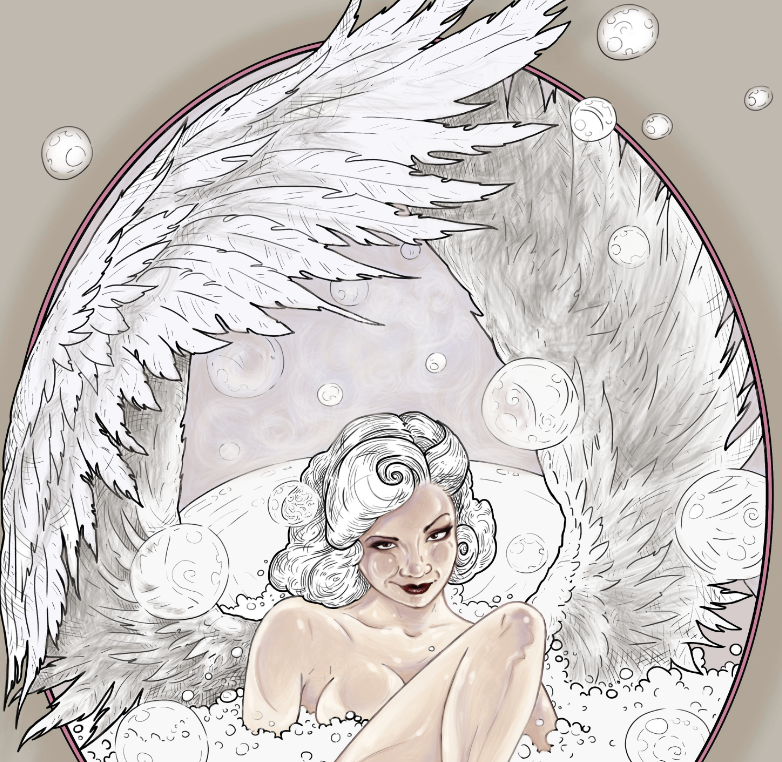
I place my shadows here. I am working very lightly, because every new layer of color that I will add will go on top of this grey. I don’t want to compete with it, but I do want to establish my shadows.
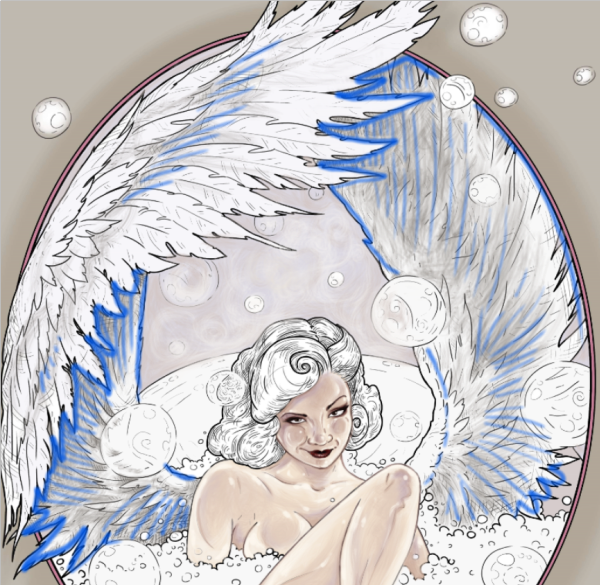
The blue lines indicate the areas where I placed the shadows.
Now I move on to my first color – a soft grayish-purple tone. I add it to the parts of the wings where I’ve already indicated some shadows. This time, I take more care to add more pigment and to make my pencil marks with the direction of the feathers. Feathers are very textured. Part of what will define your texture is your pencils marks.
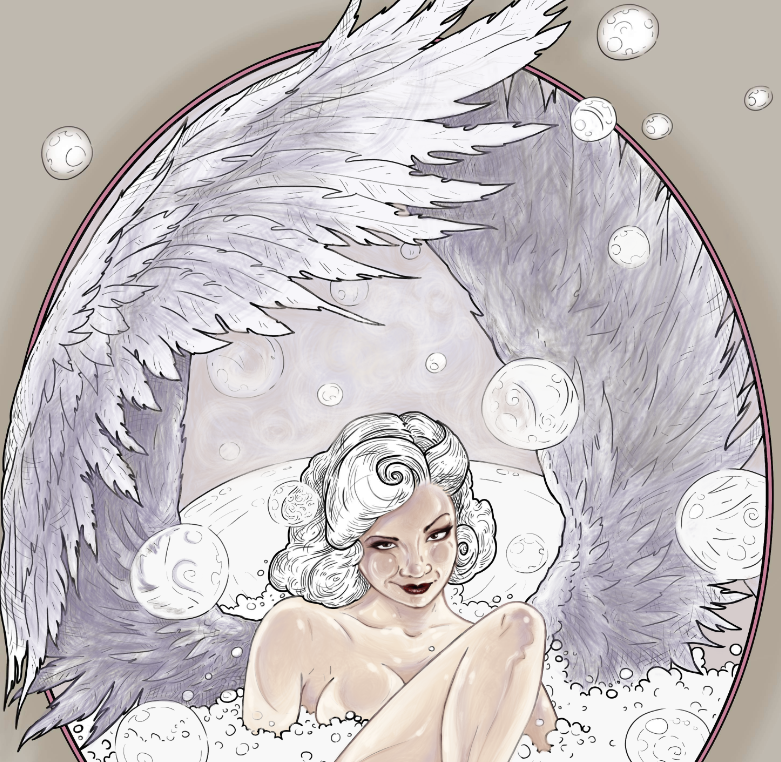
Notice that my pencil marks are still very rough, but they are starting to give the wings shape. Aways work with the shape of your object and don’t just color blocks of color between the lines. This will give your piece more dimension.
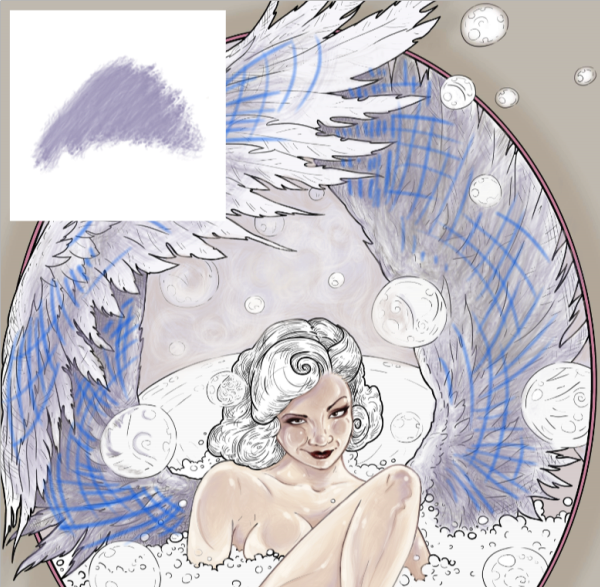
My first color on the wings and the direction of pencil marks.
The other way to add more dimension and depth to your subjects is using several colors to build one color effect. Even though I’ve decided that my wings are a solid cream color, I am actually using multiple colors to make the wings look more realistic and 3-dimensional. Granted, we are working in a more cartoony style, but I am going for the semi-realistic coloring of a comic character effect.
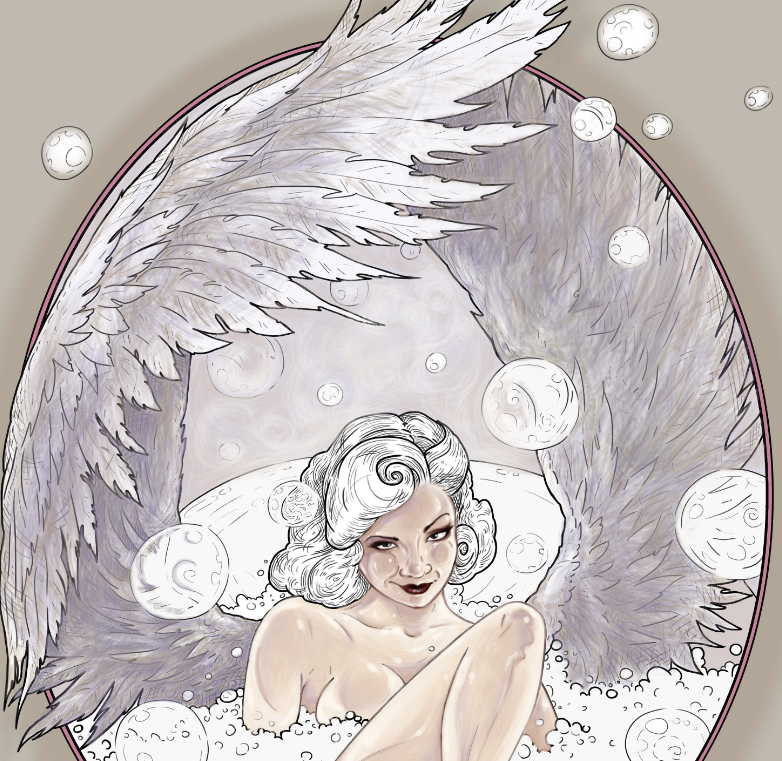
My second color for the wings is an ivory blush tone of light brown. I add it lightly here and there, like makeup powder. If I hadn’t told you that I added it, you probably wouldn’t even notice. But compare this screenshot with our previous step where I only added the purple. It’s not a dramatic difference, but somehow there is already a little bit more shape definition to the wings.
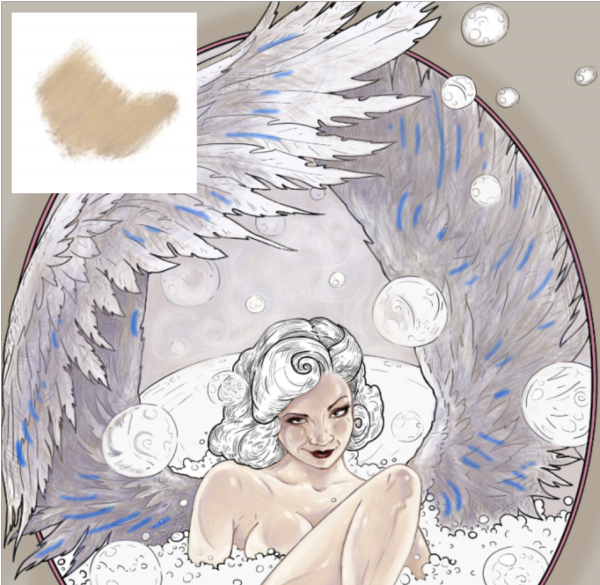
The blue lines indicate some locations where I added minor beige highlights.
So far, my wings just look kind of grey and dull. Let’s start working with the actual cream color that I promised. I select a very pale, almost yellow, beige and a complementary pale blue to go with it. I am working very delicately with both pale yellow and pale blue to complete my wing illusion, adding the lightest tones to the parts of the wings the are physically closer to us.
At this point, I actually switch back between all four of my color pencils to balance the coloring. I hide some of the black outlines with my purple pencils, and you can see that I’ve started adding some detail to the individual feathers. Note that I am only adding detail to the feathers that are closest to us. I am barely defining any feather shapes on the wing that is further away. That lack of definition helps create an illusion space. Add more detail to the objects that are closer and less detail to the objects that are further away. You can even use your smudging tool to blur that darker wing a bit.
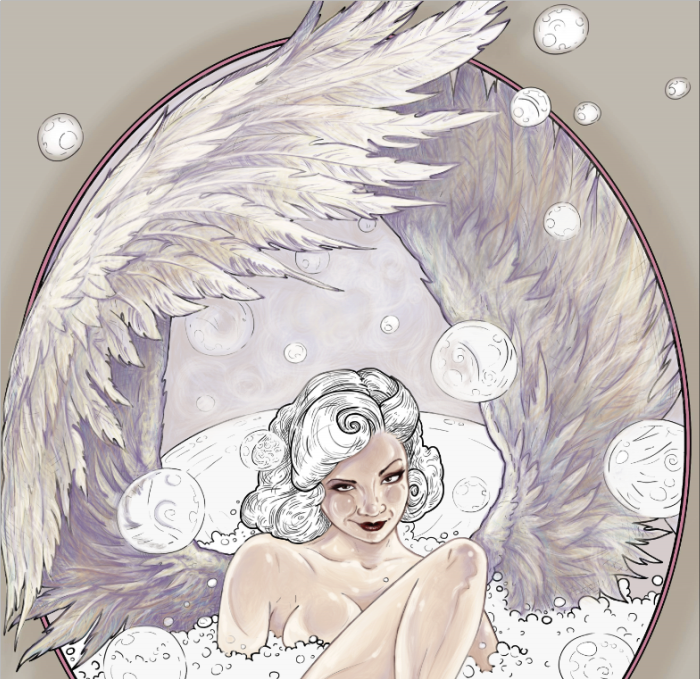
Notice how I’ve retraced the outlines in these areas with my purple pencil. That gives the coloring a softer feel, which is of course what we want, given the subject matter.
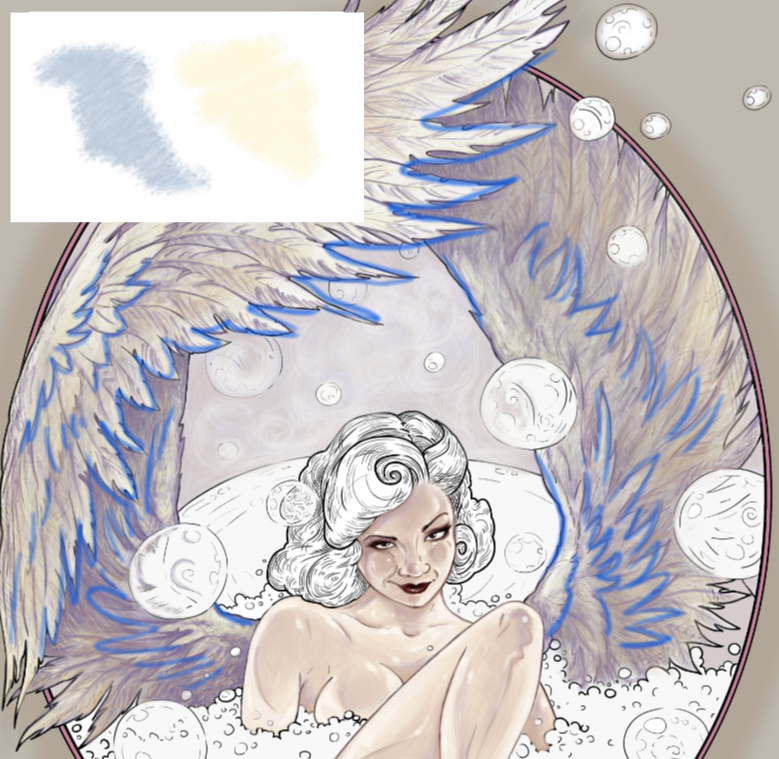
The blue lines indicate places where I retraced black lines with a softer purple.
All in all, these are the only colors that I used to paint the wings. You may finalize your wings with a touch of white highlights here and there.

Remember to always make your pencils marks in the direction of the fur or the hair or the feathers flow. The feathers are growing left to right here. My pencils strokes are also left to right. The eye of the viewer will pick up on that and see it as more natural, even if the brain doesn’t realize why the illusion works.
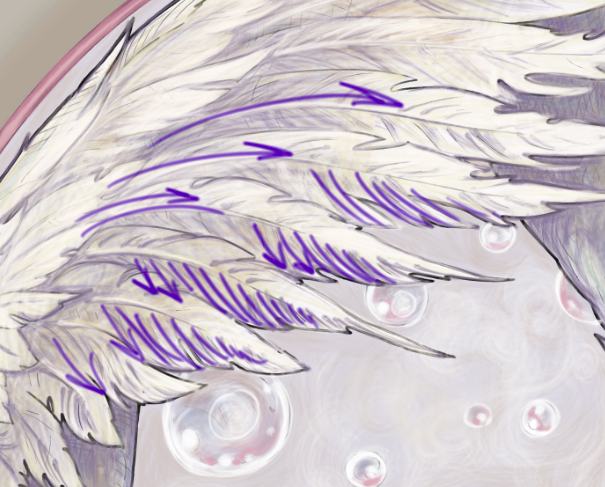
Now, I could take this further and eliminate all of the black lines. Some people take the time to do that. If this was a piece for publication or print, I would invest in that effect, but for the sake of the tutorial, I’m ok with leaving some traces of the original black outlines here and there.
You can also take this further and add really fine hyper-realistic detail to some of the feathers, but take care not to overdo the effect. When we look at objects we see concepts, not full detail. When you look at a bird with open wings, your brain does not register every single feather. It registers two symmetrical wings, the overall feather color, the overall feather texture, the darkest parts, and the lightest parts of the wings. A successful, drawing, coloring or painting is one that delivers the message in a way that our brain already interprets information. So, don’t sweat those tiny details. Sometimes, less is more. Light and shadow are far more important than detail.
All right, let’s move on. Before we can start adding bubbles all over the place, we need to finish coloring everything else that remains uncolored in the scene. In this case it’s the tub, the soapy water and her hair. I chose to paint her hair in a color that will stand out. This color will be the centerpiece of my drawing. A little burst of visual emotion in an otherwise pale and subdued scene. Plus, with a vibrant color, I can clearly demonstrate the color selection for the bubble painting.
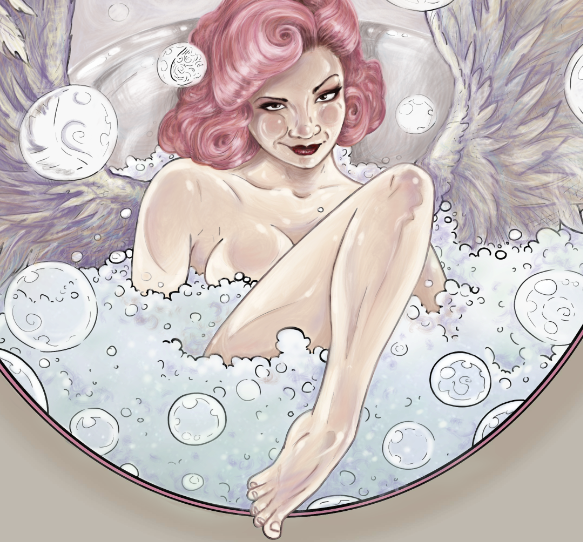
Let’s start on our first bubble. There is one floating in front of her hair.
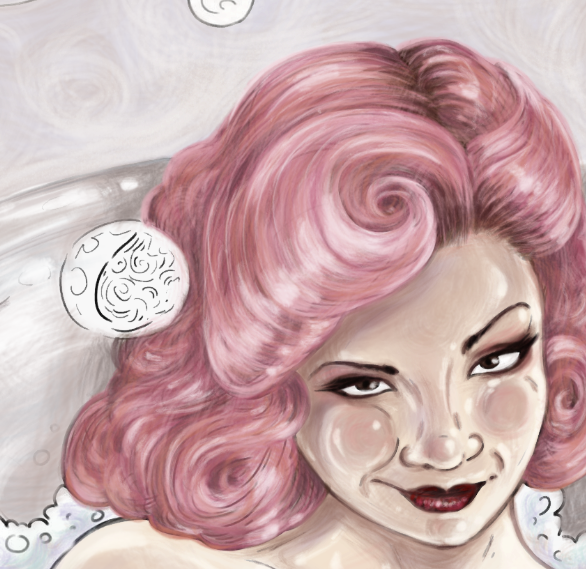
I start by working with the same pencils that I used for the tub and for the hair, and very lightly adding those tones to my bubble. I am not going for detail here at all. In fact, on the contrary, I want the effect to be blurry. In real life I would use a q-tip to smudge the color all over the bubble.
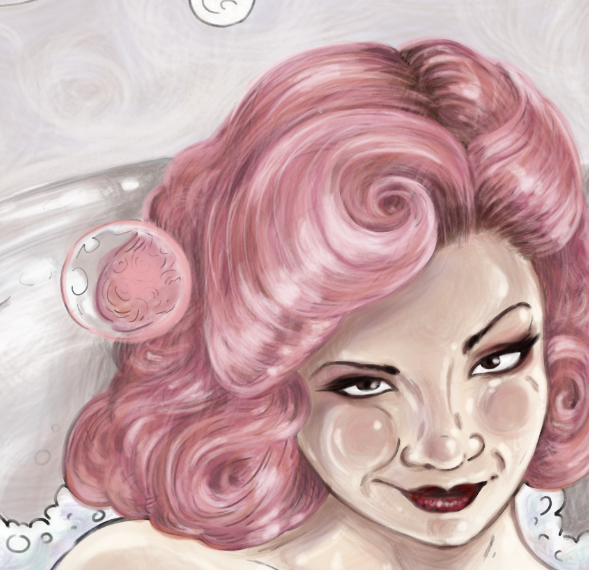
Keep in mind that soap bubbles are not just 100% clear. They are opaque, and they kind of distort everything that you can see through them. In this case, the line drawing already suggests where the colors should go. (The line drawing, of course, being made by me 😀 I like to give my colorists enough suggested information to guide them, but not so much that there is no room for their own artistic decisions).
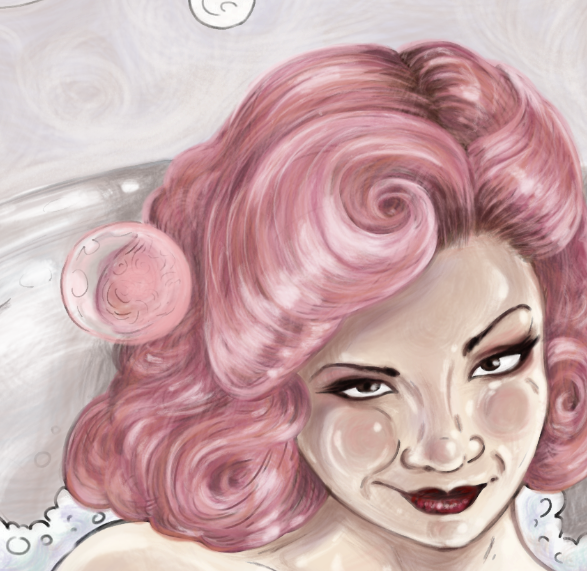
Looking at the overall color scheme of my whole composition, I pick one other color to put into my bubble to make it stand out a bit. I pick purple. I could have picked blue or beige, and they would have worked just as well. There is no one perfect or correct way to draw a soap bubble. All soap bubbles are unique and each has an element of randomness to its swirls and blurry effects.
Experiment. See what works in your composition. For instance, if you paint the rest of your scene with completely different colors from the ones I chose, making her hair green and the tub blue, inserting this soap bubble painted exactly the way that I did, will make absolutely no sense. Your bubble has to work with your color scheme.
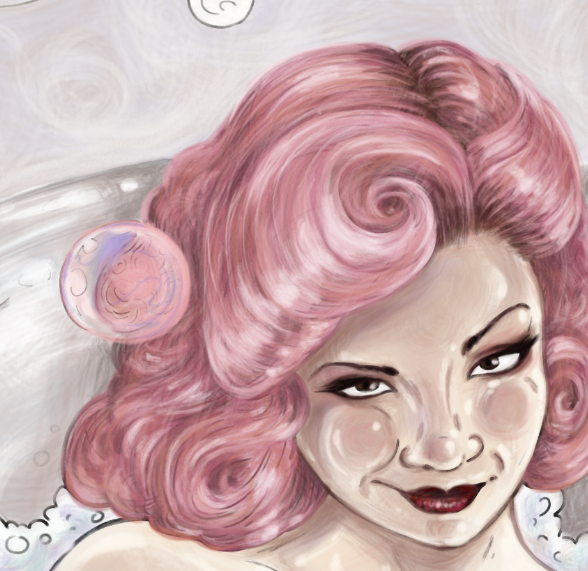
I add some white to the suggested places and also hide the black outline with pink and white. As much you can, try to make the soap bubble outline white. That will really help with the illusion of weightlessness. You can do this with a white marker, a white pen, whiteout, white pencils of certain brands (I like Prismacolors the best), acrylic paint, white charcoal, and many other easily available art tools. Try different things to see what works best for you.
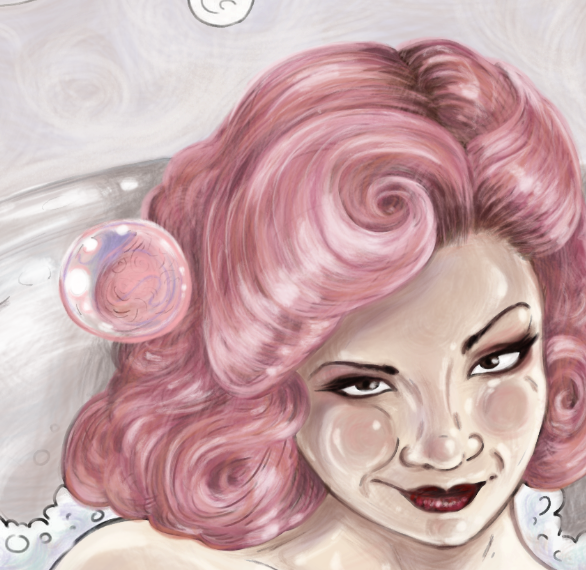
Finally, having observed my new soap bubble, I decided to add a few more little white highlights here and there, to make it a little shiny. If you are not adding white with a separate white pigment tool, take care to leave the designated areas uncolored, using the white of the paper as your lightest sections.
Remember the element of randomness. There is no one formula for where the white dots and circles should go. It’s all about what feels right to your eye. I tend to keep the center of the bubble a little darker and the edges lighter. For me, this is the perfect effect.
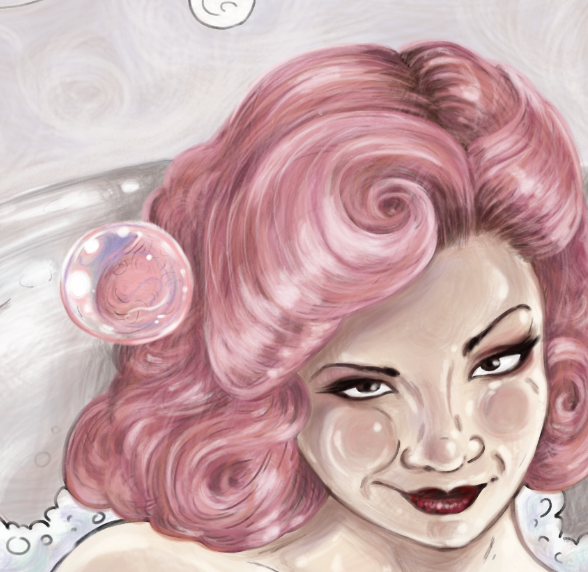
I am happy with how this bubble turned out. Let’s move on to the next. How will this bubble be different? Well, the most obvious thing we can see about this one is that it is in a different location, with different colors surrounding it.
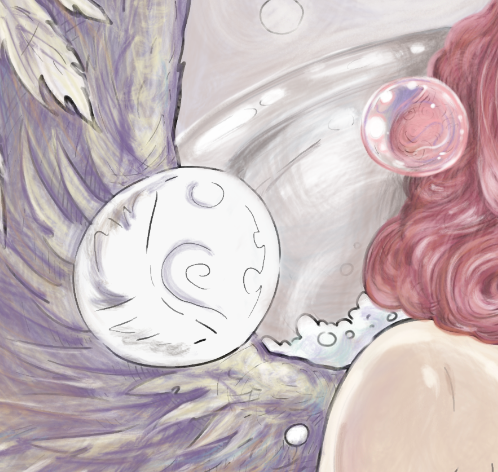
I use all the colors that are around this bubble, but I make them slightly more pale, because bubbles are soapy, and once again I am going for the smudgy effect.
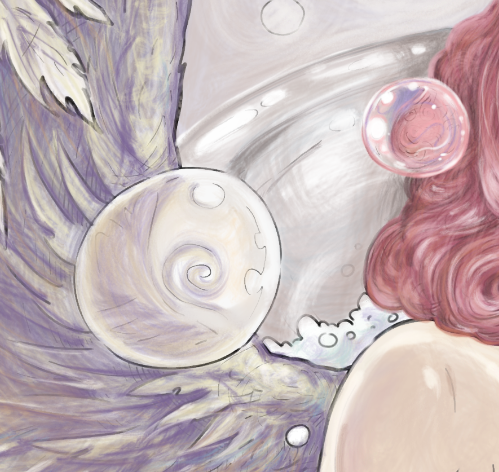
I add some pink glow on the side of the bubble that is closest to the pink hair. This is very import. This will be true for every bubble that we color. I want an obvious pink reflection on every significant bubble, on the side that is closest to her hair. This should be consistent throughout my piece.
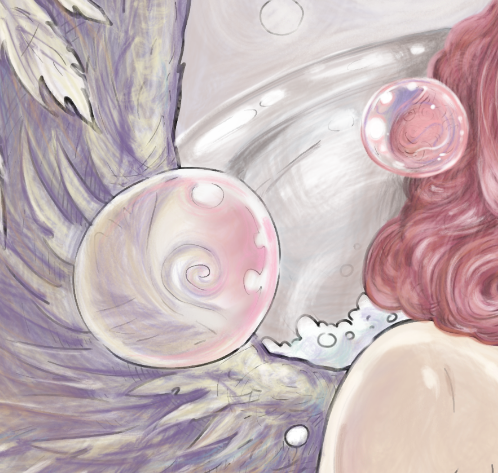
I complete this bubble with some white highlights. Notice that they are different in size and placement from our first bubble. A common mistake that colorists make is coloring every bubble in exact same stencil way. That just doesn’t look natural. The light is playing off of everything in this setting. Bubbles are even reflecting other bubbles. We are not going to get technical and photorealistic here. I want to stick with the cartoony style, but we can imitate a realistic look by staying true to that element of randomness we talked about.
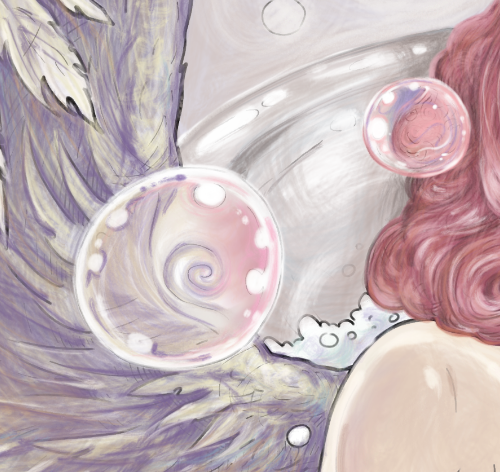
Every bubble should be unique and working with its surroundings. Let’s take a look at a few other examples. Notice that the bubbles are in fact colorless. This is why you cannot “color” a bubble without first coloring the rest of the scene. They are little prisms for other colors around them.
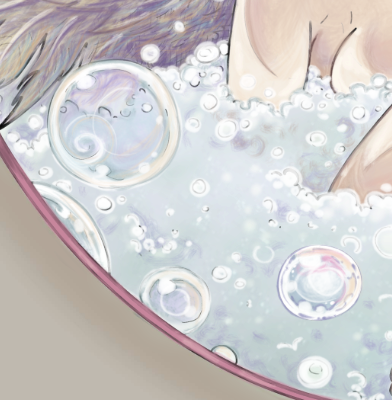
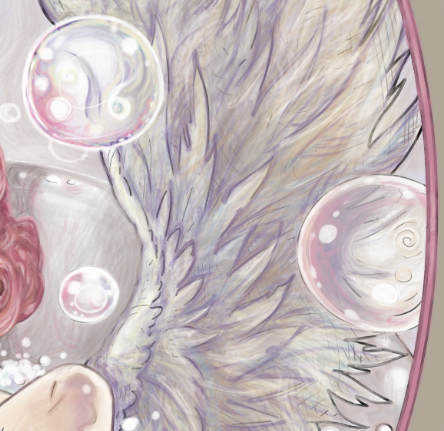
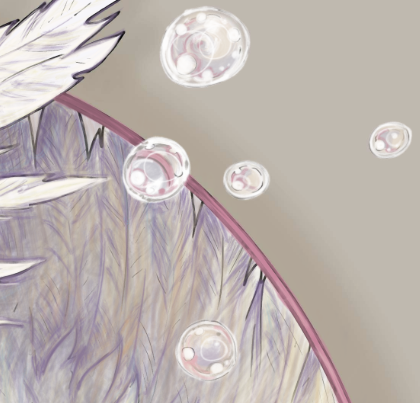
Now that all my bubbles are complete, note how each of them is perfectly unique and random, yet they all have one consistent principle – the reflection of the pink hair color. The pink glow is not just randomly placed here and there. It is very strategically placed on each bubble directly opposite the source of the color.
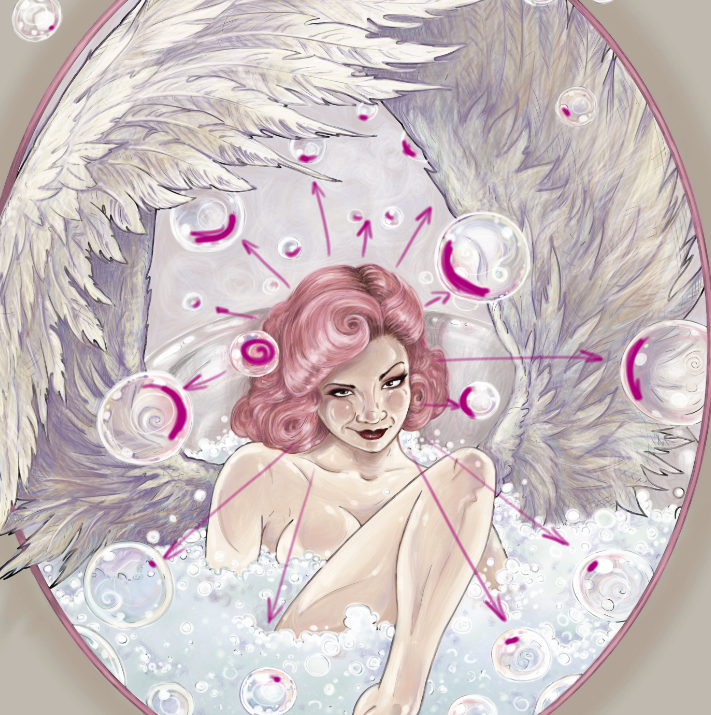
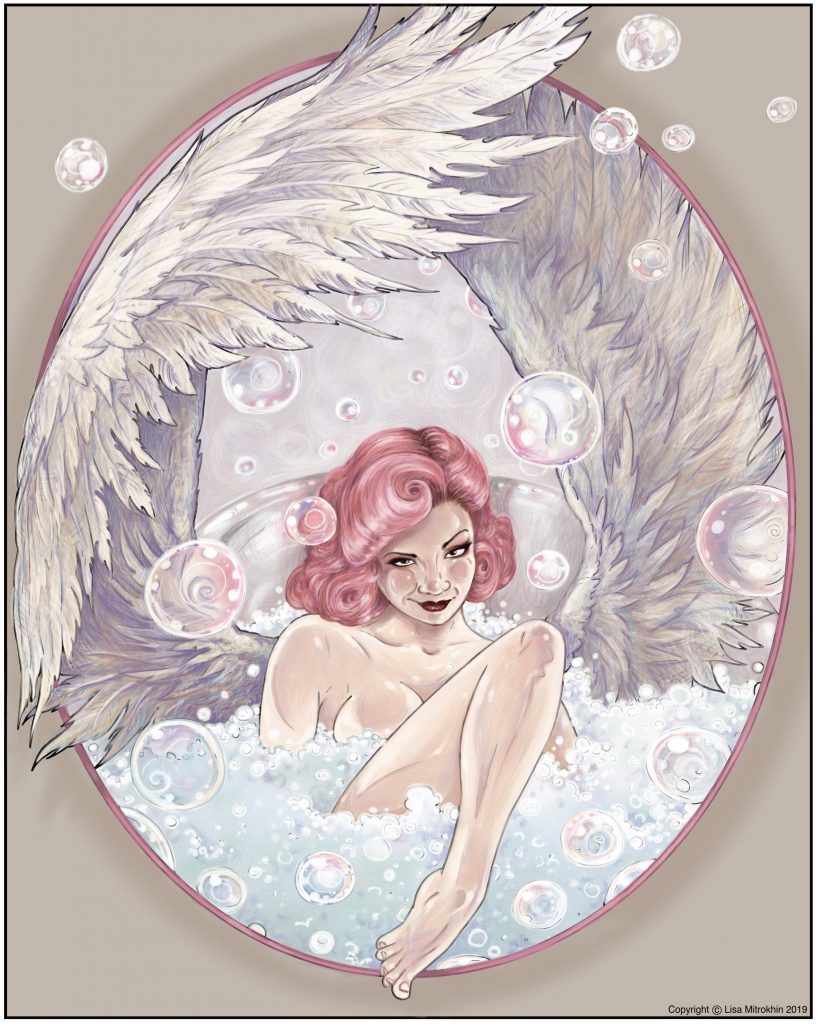
Now that my coloring is complete. I look over the entire composition, and study it. Is anything off balance? Does anything look too dark or too light? Do any of the bubbles stand out in some awkward way? This is the time to tweak little things here and there to bring everything to perfect harmony. I don’t see anything obviously wrong with my coloring, other than my overall tone. Looking at it now, it’s too crisp and there is too much pure white. I would prefer to look at this scene through a yellow or an orange filter. If I were working with real pencils, I would pick a few golden yellow tones and begin to carefully add some highlights here and there. Working digitally, I can skip 15 or 20 minutes of tedium by adding a single layer in the filter color that I like. Sorry, had to cheat at least once during this tutorial. You know me. 😉
Here are the two versions of my finished piece. Honestly I like them both. Both are perfectly fine, and I could have achieved the second effect from the very start. The yellow light effect just didn’t occur to me until I saw the final piece.
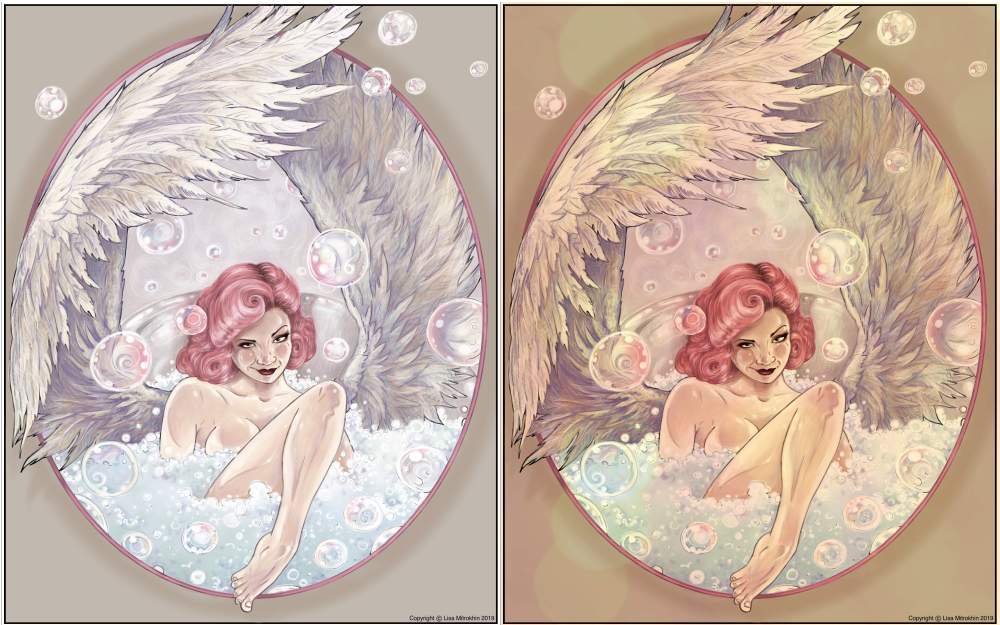
So, here she is – a winged angel in a bubble bath.
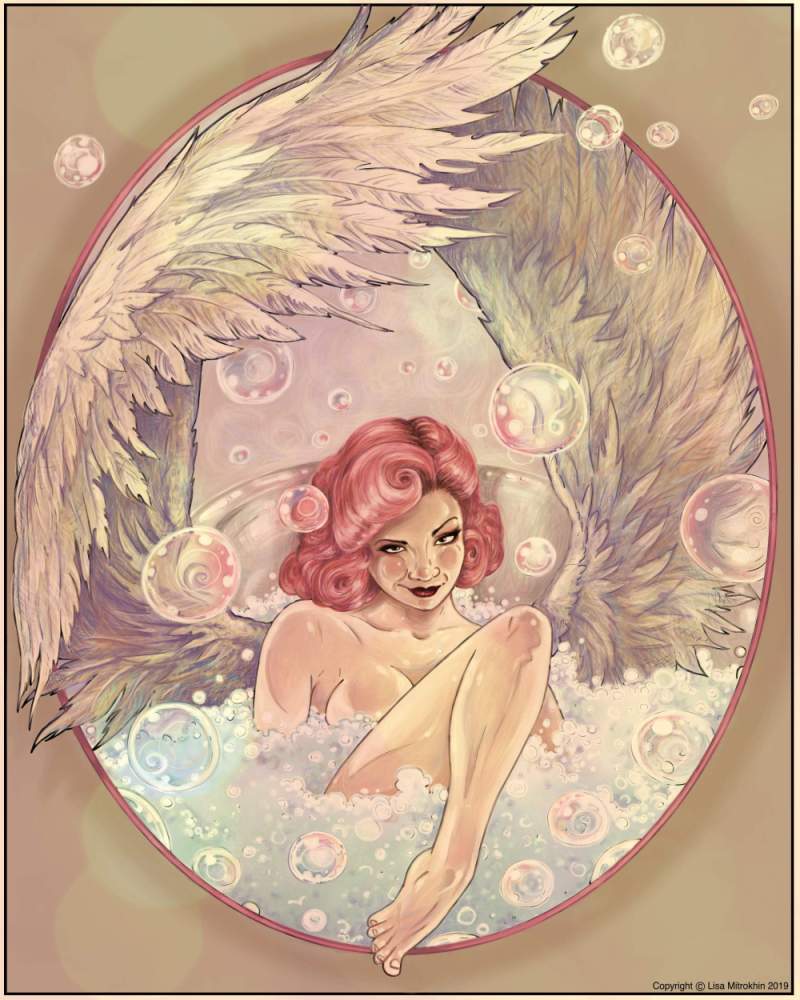
I hope you enjoyed this tutorial. The line drawing version of this page will be offered for a one-time coloring event in TALM, the winner of which will also receive a kick-ass prize, like this one. Remember that this is by no means the one and only way to approach feathers and bubbles. I highly encourage you to experiment and also to remain true to your own style.
If you enjoy my work, and wish to come join us in these fun events for a chance to win cool prizes, I hope to see in my group, TALM. Just click here, and join the fun.
Special thanks and congratulations go to Leatha Loftis, the winner of my 5 de Mayo event. This was the coloring that won her this tutorial.
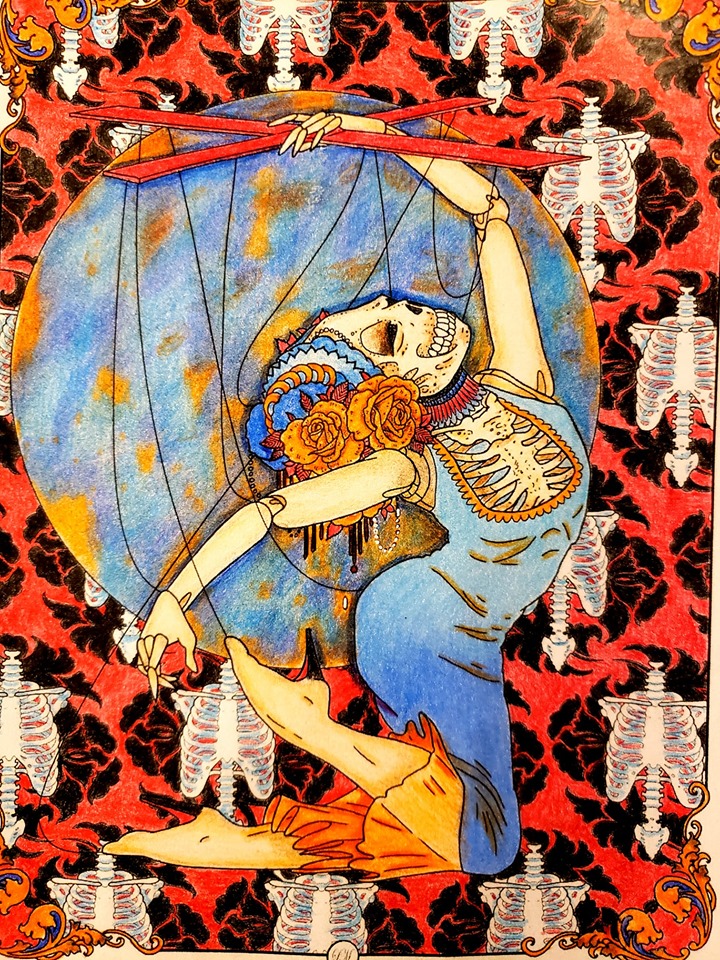
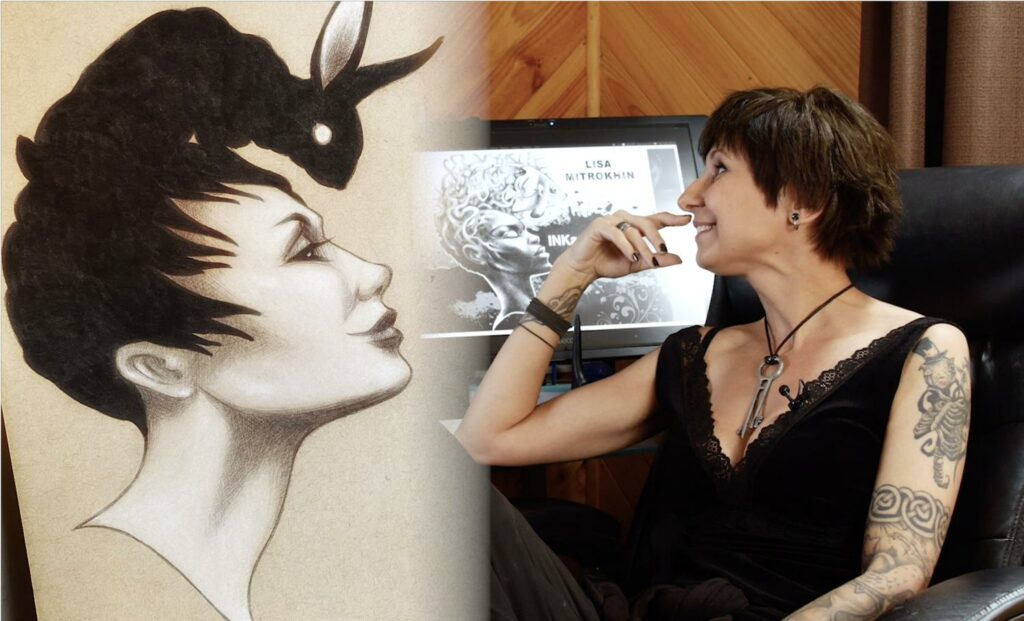
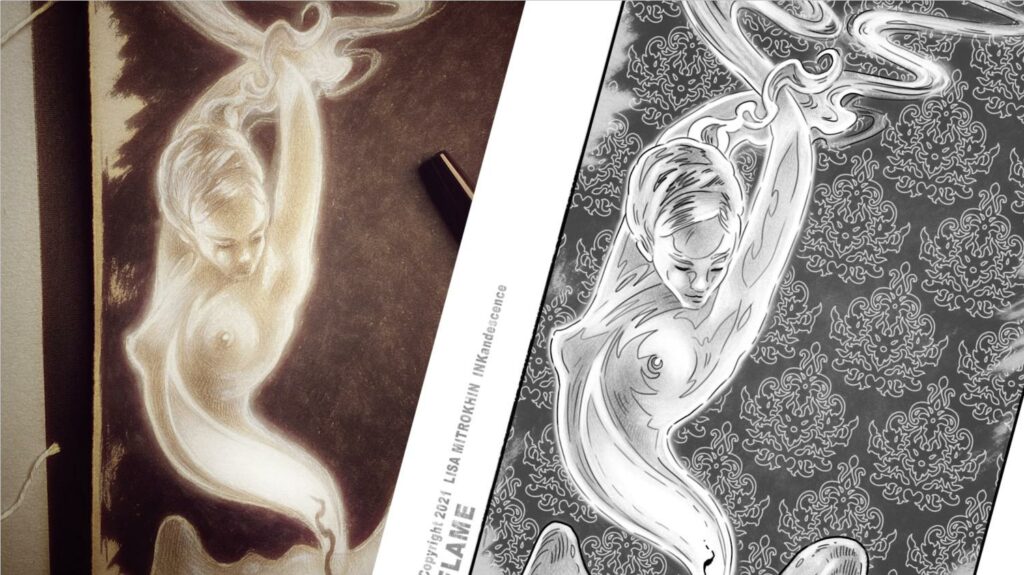

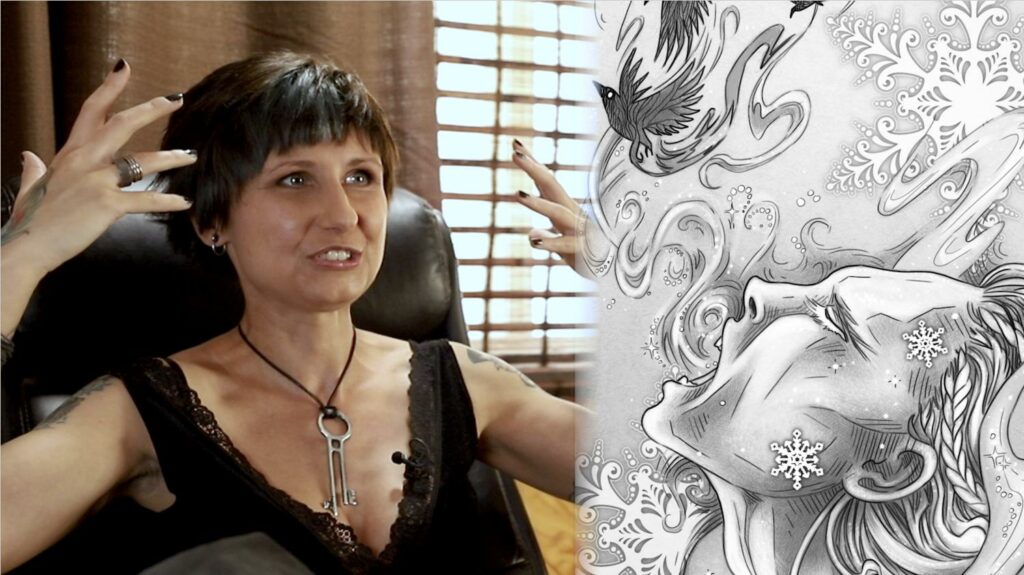
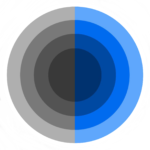
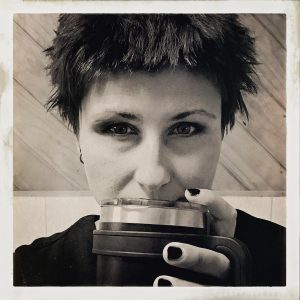
 2. Keep company of positive and happy people
2. Keep company of positive and happy people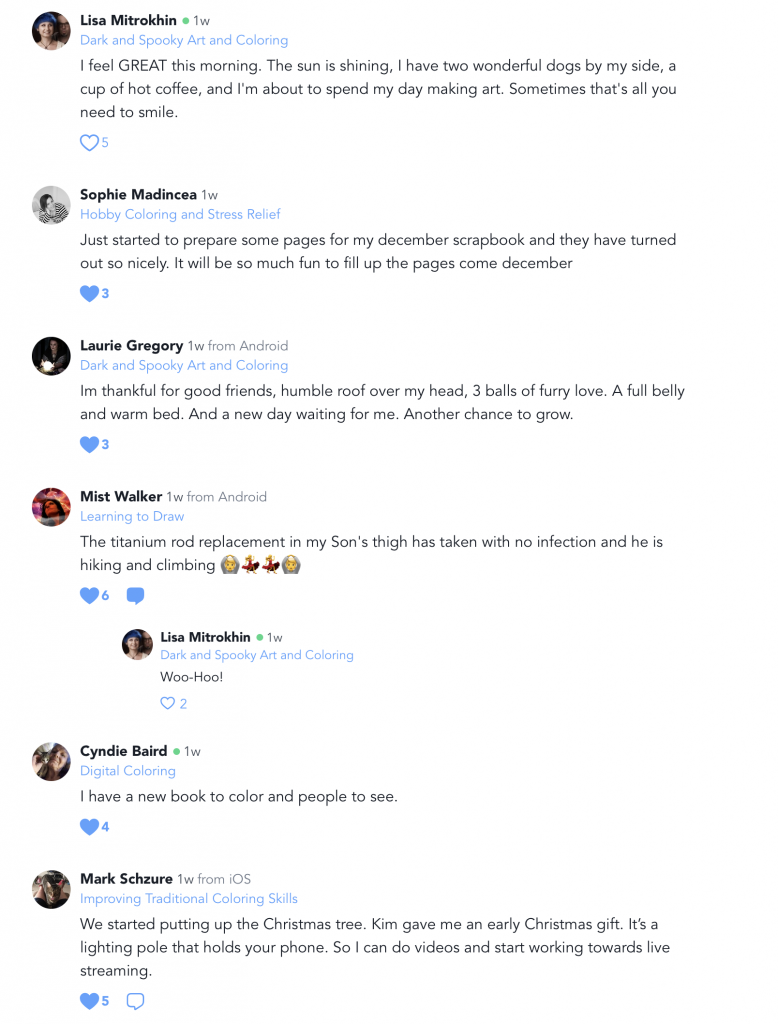 However, this step is expremely important. You NEED to find positive company and keep it. Think about all the times that a friend, a family member, or a colleague were not feeling so hot and you kept them entertained and cheered them on. Did you feel like they were dragging you down in any way? Probably not. You were probably glad to help out becasue you cared about this individual. And, if you had the opposite experience, you probably just distanced yourself.
However, this step is expremely important. You NEED to find positive company and keep it. Think about all the times that a friend, a family member, or a colleague were not feeling so hot and you kept them entertained and cheered them on. Did you feel like they were dragging you down in any way? Probably not. You were probably glad to help out becasue you cared about this individual. And, if you had the opposite experience, you probably just distanced yourself.
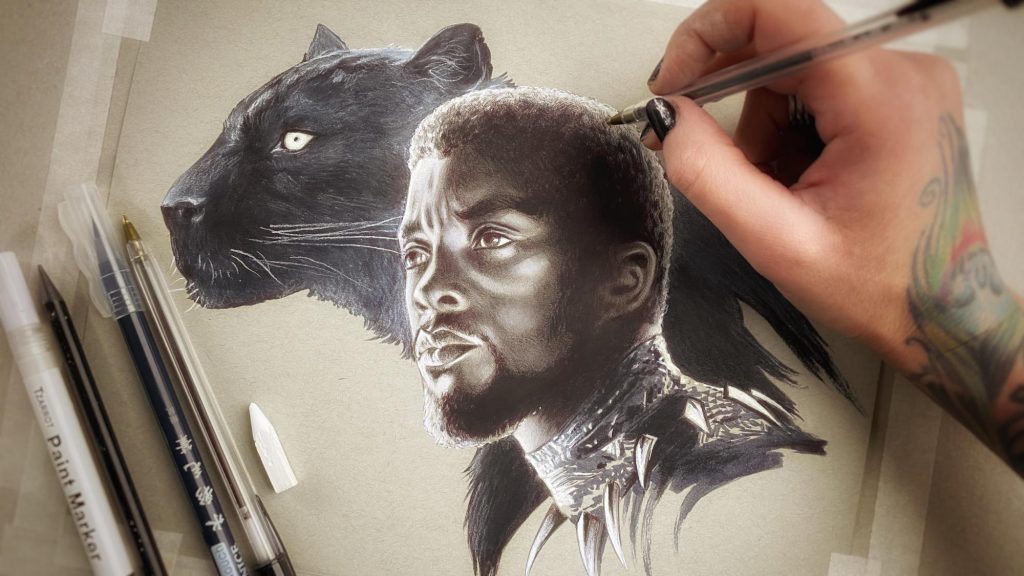
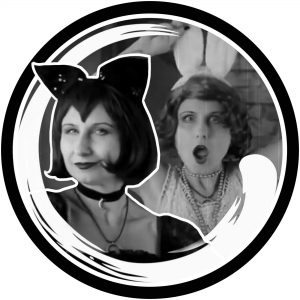
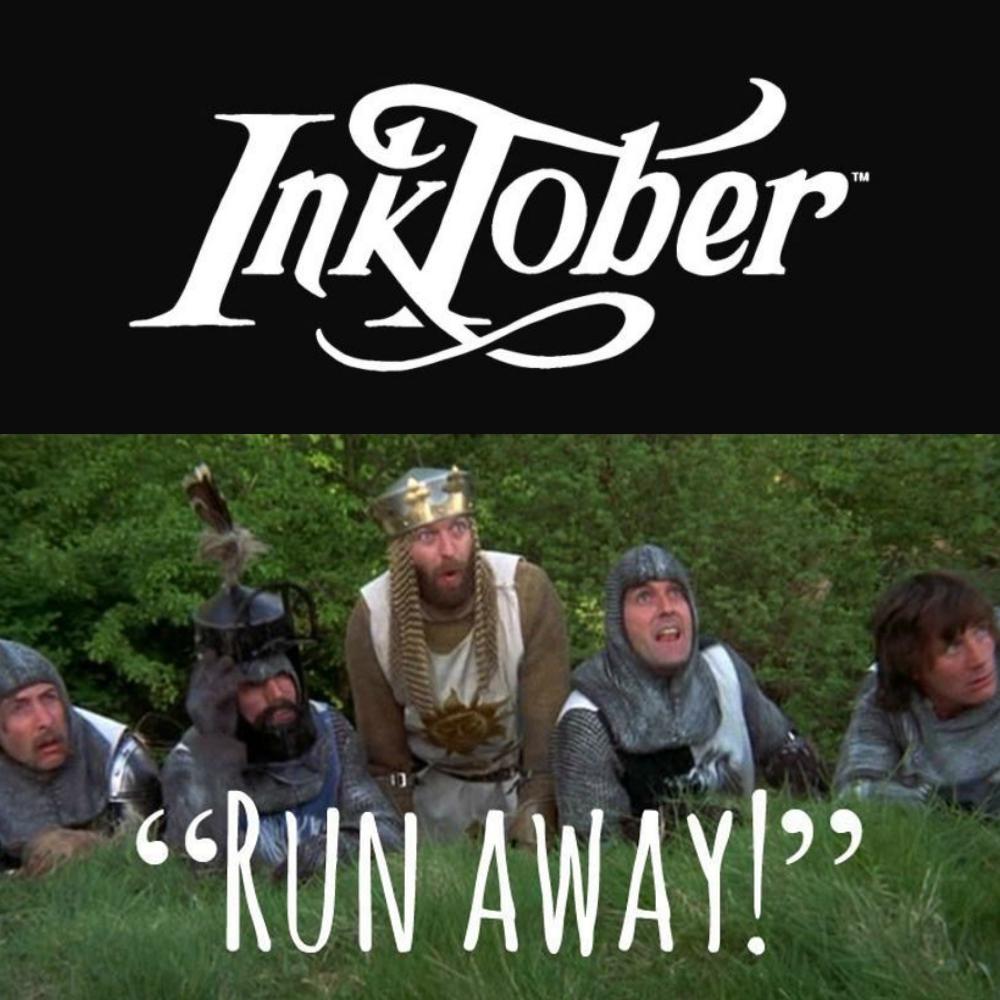
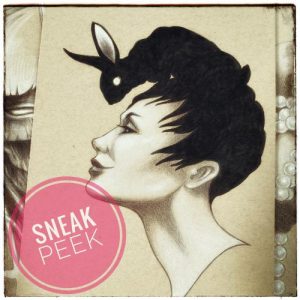
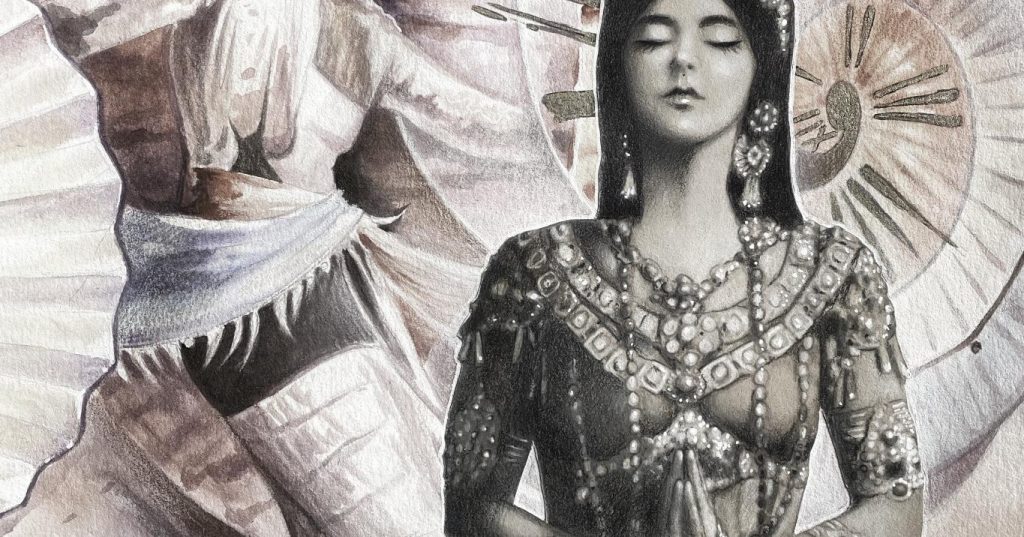
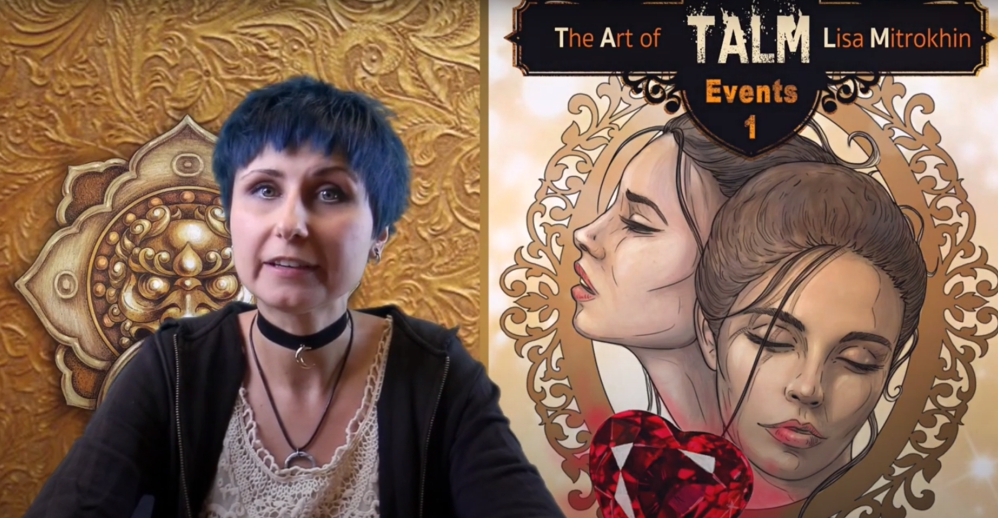
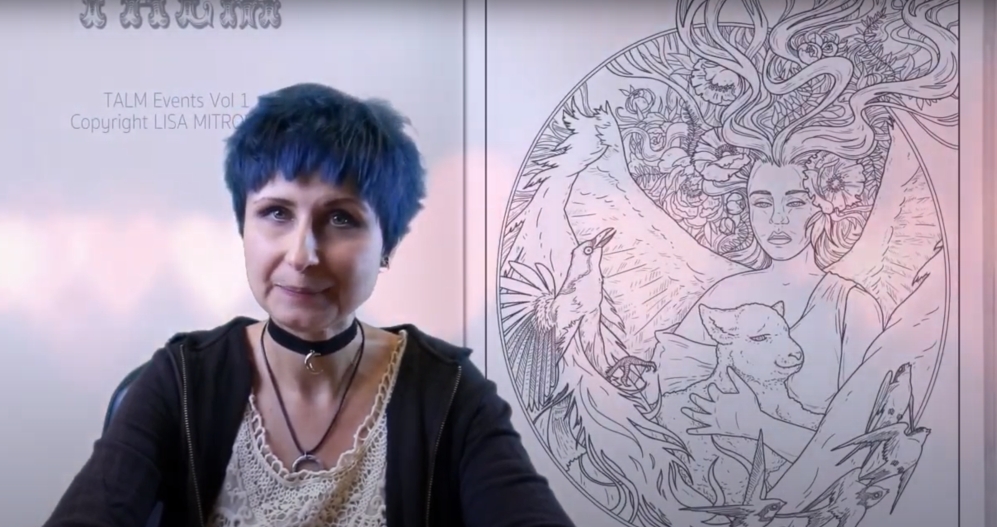
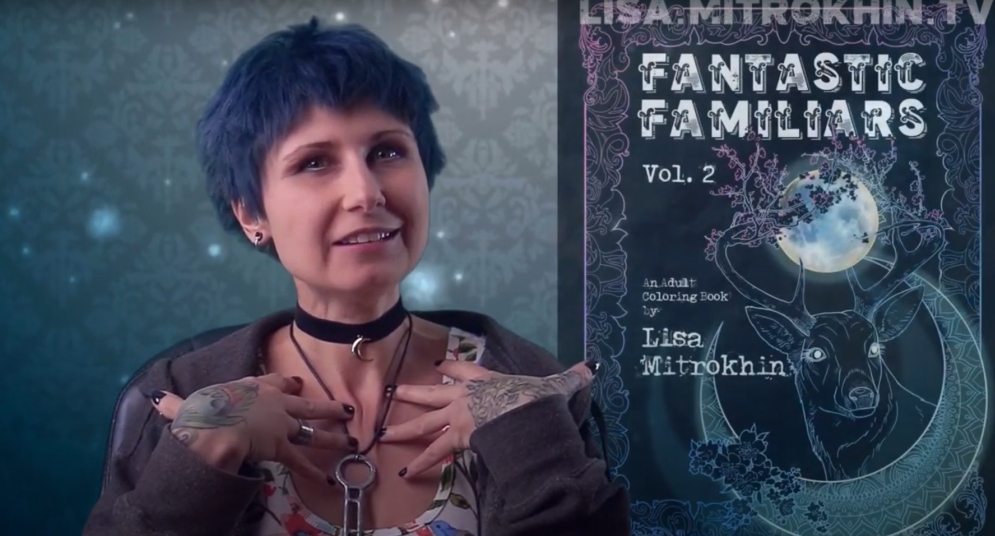
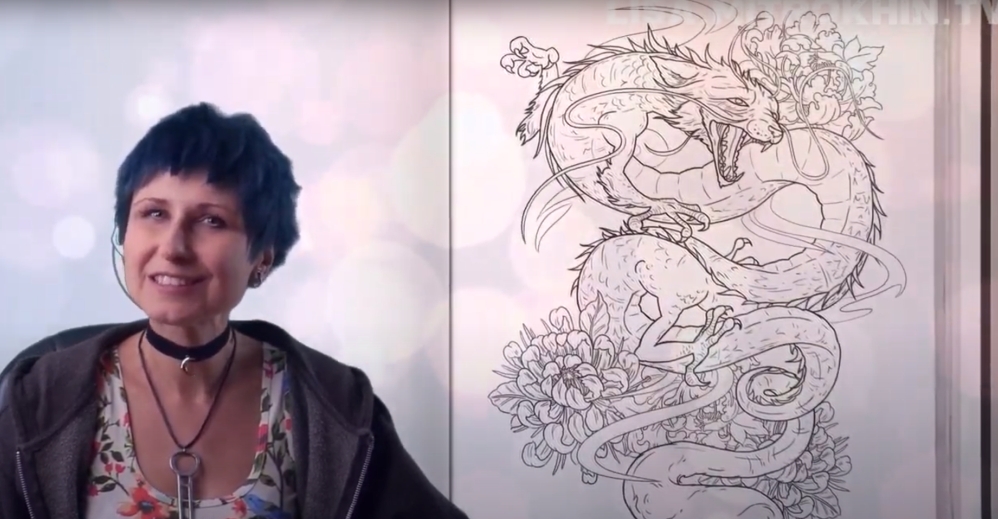

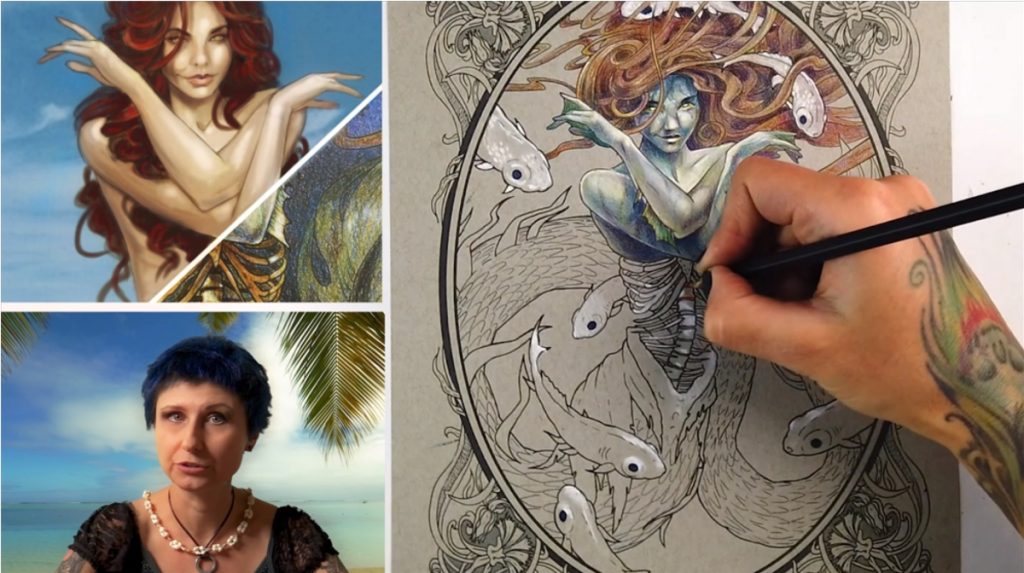
 Building an audience is as big an art form as the actual art that I share with you, and this is where things come full circle. Remember back when I could not for the life of me think of the shiny black camera lens as my friend? Well, now I can. In fact, now I have a difficult time seeing anything other than a curious, smiling face staring back me, because that’s essentially what’s happening.
Building an audience is as big an art form as the actual art that I share with you, and this is where things come full circle. Remember back when I could not for the life of me think of the shiny black camera lens as my friend? Well, now I can. In fact, now I have a difficult time seeing anything other than a curious, smiling face staring back me, because that’s essentially what’s happening.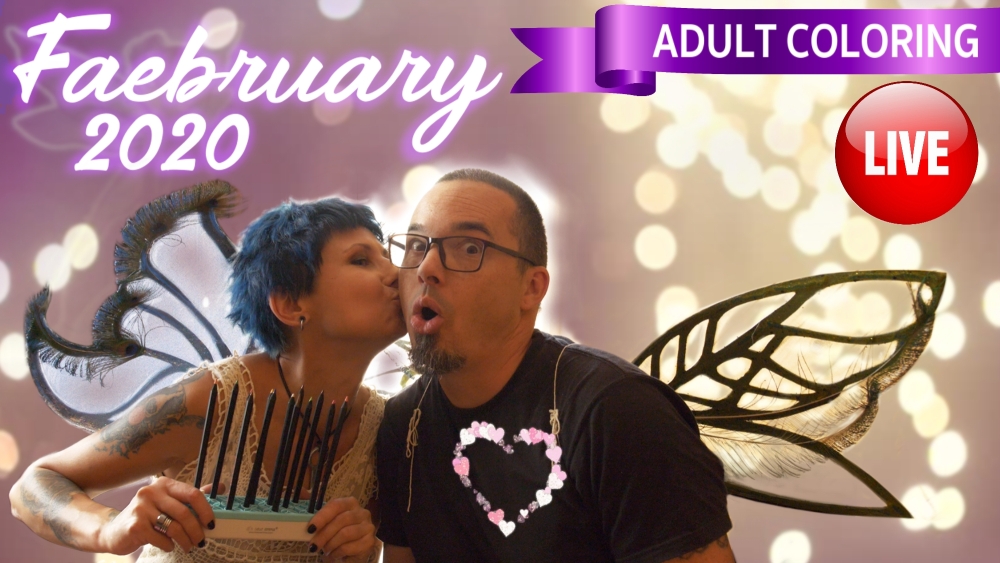
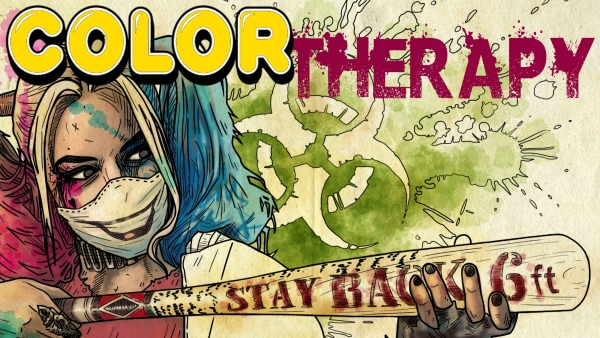
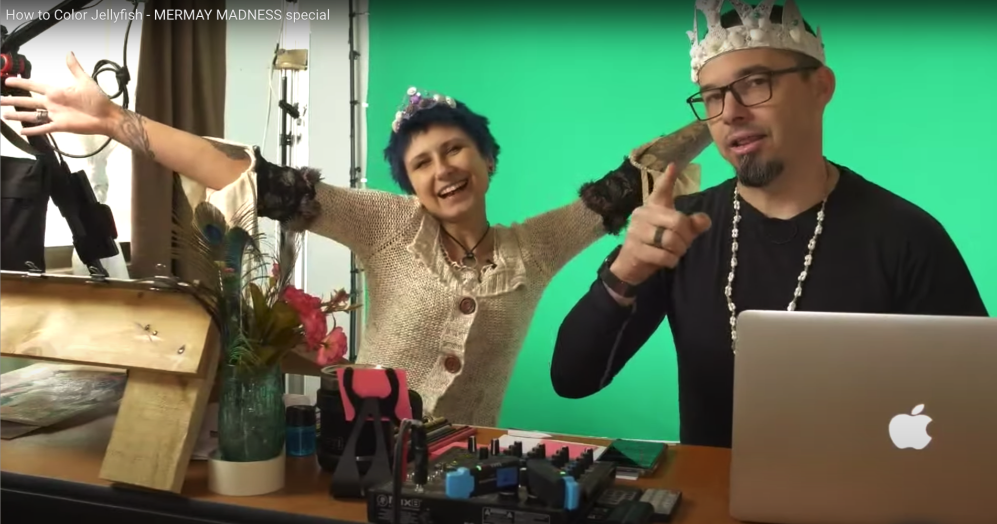
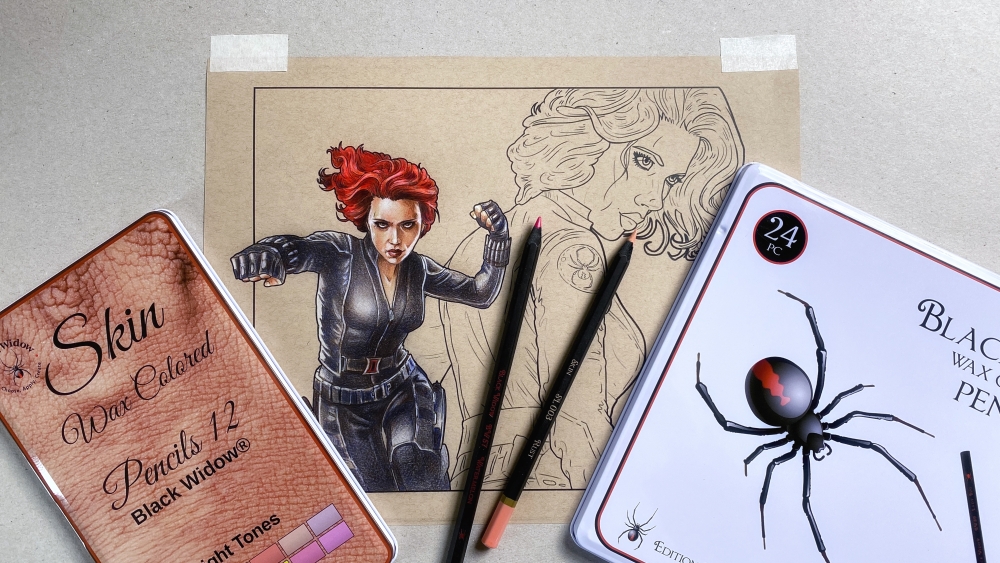
 Many don’t realize, but video production takes A LOT of time, time that I don’t get paid for. What you can do to help my channel grow and succeed is simple. All you have to do is watch my videos all the way through, and hit that thumbs-up button. That’s it. It’s free and fun.
Many don’t realize, but video production takes A LOT of time, time that I don’t get paid for. What you can do to help my channel grow and succeed is simple. All you have to do is watch my videos all the way through, and hit that thumbs-up button. That’s it. It’s free and fun.